#Fantasy Guide to A Great House in the 19th-20th Centuries
Text
Fantasy Guide to A Great House (19th-20th Century) - The Lives of The Family
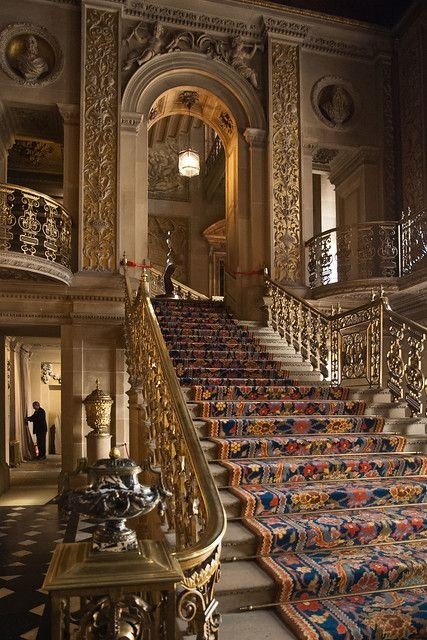
When we think of the Victorians, the grand old Gilded Age or the Edwardians, we all think of those big mansions and manors where some of our favourite stories take place. But who lived here and what did their lives too like?
Who are the Family?
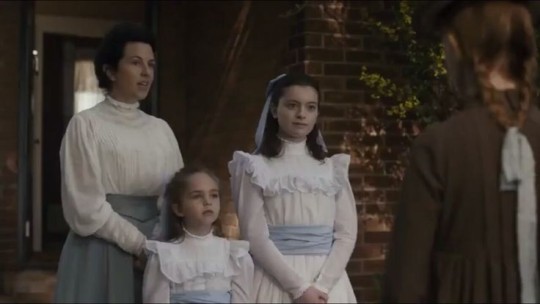
The family are the owners of the house. They are the employers of the servants, the caretakers of the house/estate. Since we're discussing a great house family, they are usually upper-middle class or nobility. A family can consist of a couple and their children but since great houses are so large, sometimes extended family members would live with them such as unmarried aunts or widowed mothers.
Roles Within the Family

In this era, the gentleman of the house would be the head of the unit, even if his wife holds their title in her right. They were in charge of hearing the troubles of the tenants, they would meet with representatives from the estate, deal with lawyers and other officials. He would often meet with the butler to discuss the household but would not be totally involved in its day to day running.
The lady of the house was heavily usually involved in the running of the household. She would meet with the cook daily to discuss menus, work with the housekeeper to ensure the smoothing run of the house during and outside events, keep an eye on the household accounts, the stock of supplies and the welfare of the servants. She would be in charge of her daughters' education and would will also be heavily involved with the local charities of the region.
Children lived relatively seperate lives from their parents. They would usually be cared for by nannies, nursemaids or governesses. They would eat seperately, sleep in the nursery and usually be left behind while their parents travel for the Season. Sons may be educated outside the house, usually sent off to boarding school. When they are passed their education, they would move out of the house (unless they were the heir, then they may be expected to stay around) and join high society. Daughters would live at the house until they are married. It's common for unmarried daughters to remain in the household as spinsters, even after the death of their parents. Daughters would be educated in the house by their governess and their mother.
The Daily Schedule

Morning: At 9, the family would be awoken by the arrival of their hot water. Married ladies have the luxury of staying in bed to eat breakfast. Valets and lady's maids would arrive to dress the family after being summoned by the bell. Unmarried women and the men of the house would eat breakfast in the dining room. After breakfast, the couple would withdraw to their business of the day, such as meeting with estate agents or dealing with paperwork. Just before midday, the lady of the house meet chef to discuss menus. The children would go off to their lessons with their governess or tutors. Luncheon would be served at 1. After luncheon, the ladies of the house may travel to appointments such as fittings or paying calls to friends.
Afternoon: Tea would be served around four. After the tea is finished, the children would be brought down to spend time with their parents. With tea finished, the gentleman and lady would finish their work.
Evening: At 8, the butler signals the start of supper giving the family and any staying guests, 15mins or more to get ready. Valets and lady's maids would already be upstairs at this point, helping their master/mistress with dressing. When the family head downstairs, they linger in the drawing room to chat. They would dine together. The ladies would adjourn to the drawing room for coffee and tea while the men stay in the dining room to drink and smoke. When the men have finished, they join the ladies before going up to bed.
Social Aspect of the Great House
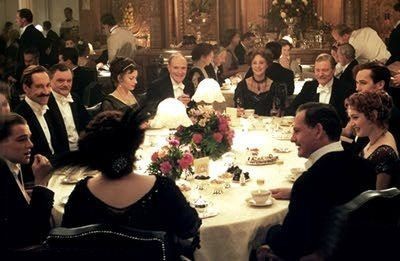
One of the main functions of a great house is society. The family would host gatherings in the off season when they aren't in the city for the social season. If one lives in the country, one might be expected to host relatives on hunting/stalking/fishing holidays. All those extra rooms can be let to guests staying the night. Bachelors would be kept on seperate floor from the unmarried daughters with couples rooming together or side by side. The Great House family is expected to be gracious hosts and spare no expense to their visitors. Servants would have to do many times more work and put up with a lot of nonsense because of the added work load.
#Fantasy Guide to A Great House#A great house: the family#Noble families#Writing guide#Writing reference#writing resources#writing resources writing advice#writing advice writing reference#writing advice writing resources#writeblr#writing reference#writing advice#writing reference writing resources#Fantasy Guide#The great house#Fantasy Guide to A Great House in the 19th-20th Centuries#19th 20th century
425 notes
·
View notes
Text
what i read in april
in which i read two (!!) 5-star-adjacent books and also defeat my nemesis thomas mann
the paper menagerie & other stories, ken liu
impressive collection of (mostly) scifi short stories with some fantasy elements. liu is particularly interested in historical/collective memory, historiography, textmaking and textuality, and the importance of stories. my favourites were the bittersweet title story (feat. living origami animals), an alternative history story about the construction of an underground tunnel between japan and america, and the last story, in which time travel becomes tied to politics of remembrance. some stories are not as strong, especially an honestly boring take on AI/voice assistants/surveillance, but overall these are really good, especially in how they approach SFF from asian perspectives. 3.5/5
der zauberberg/the magic mountain, by my nemesis thomas mann
THE EVIL IS DEFEATED!!! after 1.5 months i finally finished the magic mountain & honestly.... i really liked it. literally all that happens is that a sweet young fool called hans castorp goes to a mountain sanatorium in switzerland to visit his cousin for three weeks and then.... just stays there for 7 years even tho he ISN’T REALLY ILL (which is both incredible dumbassery & incredibly relatable). up there he hangs out with a lot of people, has lots of conversations about politics & philosophy, falls in love w/ someone, some people die, some people leave, hans takes up skiing, everyone becomes obsessed with seances & psychoanalysis & whatever else for a time, there’s duels, and most of all, thomas mann is like HEY TIME IS WEIRD AM I RIGHT??? and it is! it is pretty weird. things i didn’t expect: a) it’s honestly pretty funny, b) i had several feelings (’als soldat und brav’), c) i kind of knew what the ending was going to be but still i was. distraught. ANYWAY. sometimes.... books that are classics.... are really quite good. 4/5
city of dragons + blood of dragons (rain wild chronicles #3-4), robin hobb
i really enjoyed this series even tho i think these two are not as strong as #1-2. the central characters & relationship dynamics are great, i was happy to see malta back, and i loved the new plot points here (trader conflicts! hest coming to the rain wilds! most of all, chassim and the chalcedean women’s liberation front!!!) BUT i think all of these could have done with a bit more space; it all feels crammed together at the end & not really satisfying. 3.5/5 for both these books, series rating 4/5
the hitchhiker’s guide to the galaxy, douglas adams
like, it’s funny. maybe i was not in the mood, but funny doesn’t carry a book. 2.5/5
remembering babylon, david malouf (uni)
this book is really good but it is also exactly the kind of book you read in a seminar on postcolonialism, which is what i’m doing. it’s set in a small australian settlement in the mid-19th century, where one day a strange man appears who looks like a “savage” but claims to be a ‘british object’. it turns out that he was marooned as a child and joined a native community, and his presence and strange liminal status (’the white black man’) disturb the entire community. it’s all about questions of assimilation, indigeneity, whiteness, and who owns the land, and it’s very very good, well-written, evocative of the australian landscape, dreamy and i’m probably gonna write my paper on it & end up resenting it a lil bit. 4/5
a canticle for leibowitz, walter miller jr.
post-apocalyptic monks in the desert preserving knowledge!!! i ADORED the first two parts of this with all my heart (the first set 600 years after the nuclear apocalypse in a new “dark age”, showing the canonization of leibowitz, engineer-turned-protector-of-knowledge; the second 600 years later again, when during the “renaissance”, conflicts arise between church and secular scientists), the third part (a new nuclear/space age w/ mutual destruction threatening) i liked less, especially when it abandoned the themes of cyclical history, the danger knowledge presents to humanity but also its value, and the process of science and culture rebuilding itself from the atomic ashes for a digression on euthanasia, but i still loved a lot about it, particularly the monks sent to human colonies on other planets (”remember this earth... never forget her - but never come back” made me cry). it is very steeped in catholicism (obvi) which i don’t have much of a connection with but i actually loved how the book talked about religion. on the whole, i genuinely, genuinely loved this, loved francis illuminating a blueprint for 17 years, loved benjamin/lazarus (?), the apocalypse being reframed in biblical terms, loved the melancholy & despair over humanity destroying itself again and again, and the mad mad tiny hope for peace somewhere, some time. i will read this again for sure. 4.5/5
machandel, regina scheer
perfectly fine multi-perspective novel about 20th century (east) german history, all revolving around the small village machandel (a lower german word for the juniper tree). it incorporates some interesting perspectives/topics you don’t necessarily see a lot (forced laborers from eastern europe, euthanasia programs during the third reich, a sympathetic look at the promises & failures of the gdr) and it’s a pleasant read but it didn’t resonate with me in any special way. i’m more interested in scheer’s new book, which is literally set right around the corner from me. 3/5
wild seed, octavia e. butler
sooo this is a afrofuturist-y science....fantasy (??) book about two immortal beings, doro (spirit possessing bodies) and anyanwu (healer & shapeshifter) & their complicated relationship over about 200 years. also involving a magical selective breeding programm, changing your gender, slavery of different kinds and a whole lot of babymaking. it’s interesting&unique&very immersive, but not really octavia e. butler at her best imo. i think my next butler will be xenogenesis. 3/5
kokoro, natsume soseki
early 20th century japanese classic about a young student and his mysterious mentor. very quiet and slow but still a good read. don’t have much to say about it tho - i’m probably missing a lot of cultural context. 2.5/5
the merchant of venice, willy shakes (uni)
tbh i skimmed most of the scenes shylock wasn’t in bc in this house we stan shylock & no one else, but also like why would anyone sign away a literal pound of their literal flesh as a bond for money you don’t EVEN NEED fuck you antonio.
shylock is my name, howard jacobson (uni)
the hogarth retelling of merchant. i’ve read this before & thought it was clever & sharp re: the play & shylock, but ultimately sexist & gross. i still kind of think that but i liked it A LOT more this time around; it’s really the best of the hogarth series (that i’ve read) in terms of actually engaging with & deconstructing the play rather than just retelling it in a modern setting and it does it in a really smart & thoughtful way. everything not about shylock is ridiculous and farcical but that’s really the point - all the characters beside shylock are the worst and already were the worst in merchant. still not happy about the sexism but: 4/5
the complete maus, art spiegelman
honestly it really just is that staggeringly good and given the amazing panels about beckett (x), i’m not going to say much more. if you’re interested in the graphic novel (not really novel bc it’s not fictional) and can deal with the subject matter, just like. read this. predictably, my favourite part was the beginning of maus ii, where art (post-publication of maus I) reflects on what he was doing and why (and why mice) and deconstructing the central conceit from within (see the panel linked, where everyone’s wearing animal masks and he wonders whether mentioning housepets will ruin everything). 5/5
2 notes
·
View notes
Text
10 Unmissable Exhibitions To See In 2021!
10 Unmissable Exhibitions To See In 2021!
Art
by Sasha Gattermayr

Hilma af Klint: Paintings for the Future at the Solomon R. Guggenheim in New York. Photo – David Heald.
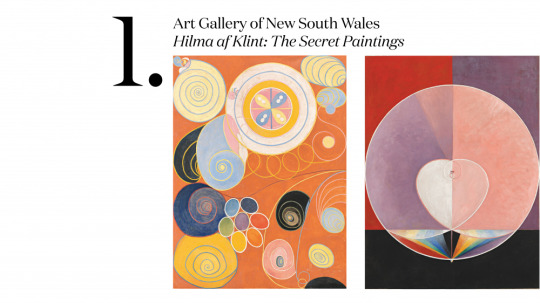
Left: The Ten Largest, Group IV, No. 3, Youth by Hilma af Klint, 1907. Right: Group IX/UW, The Dove No.2 by Hilma af Klint 1915.
Hilma af Klint: The Secret Paintings
12th June – 19th September 2021
Art Gallery of New South Wales
You might recognise the pastel tones and soft, mystical forms of Swedish visionary Hilma af Klint. The 2019 exhibition of her newly discovered paintings at New York’s Guggenheim drew record-breaking crowds, and was broadcast all over Instagram. But nothing substitutes for the real thing!
The 100 works that comprise The Secret Paintings will premiere in the Asia Pacific at the Art Gallery of New South Wales this winter, which will be the first major survey of the experimental artist’s work in the region. The existence of the enormous, ambitious canvases was not known until recently when they found in storage after being kept there for the last few decades… unbeknownst to the art world!
Now brought to light, the dazzling exhibition represents an outpouring of appreciation for the trailblazing modernist artist. Don’t miss this international art sensation!
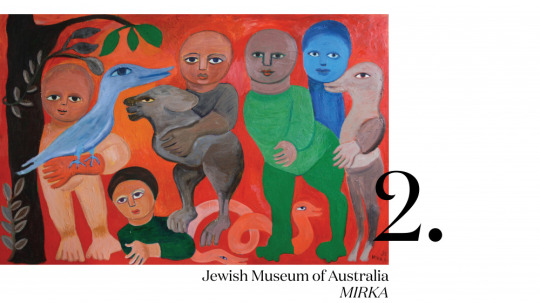
‘Friend Under the Tree‘ by Mirka Mora.
MIRKA
14th February – 19th December 2021
Jewish Museum of Australia, Victoria
It’s no secret we’re HUGE Mirka Mora fans, but this is big… even for us! MIRKA is the most expansive survey of the late, great artist’s work and dives deep into her rich personal history as well as her vibrant creative oeuvre.
After pushing back the opening due to last year’s restrictions, the Jewish Museum of Australia will transform into a ‘Mirka-world’ on Valentine’s Day, featuring more than 200 unseen pieces from the Mora family home and Mirka’s studio and archives. These will be featured alongside pieces from Heide’s permanent collection to create a vivid account of her life as a Holocaust refugee in Australia.
Visitors will be guided through the exhibition of artworks and personal effects by an audio soundscape of stories and memories – narrated by Mirka herself! This will be a truly immersive show of a Melbourne icon.
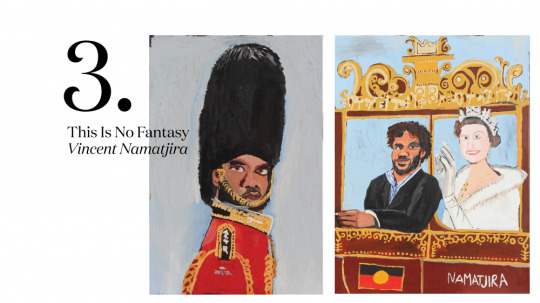
Left: The Royal Tour (Self Portrait 1), 2020. Right: The Royal Tour (Vincent and Elizabeth), 2020.

The Royal Tour (Charles, Vincent and Elizabeth), 2020.
Vincent Namatjira
8th – 25th September, 2021
This Is No Fantasy
2020 was Vincent Namatjira’s year. The artist received an Order of Australia in June, and then took out the prestigious Archibald Prize a few months later, becoming the first Indigenous artist to win the country’s most prestigious portrait prize. AND he released a book in December!
Originally from Ntaria (Hermannsburg), Northern Territory (125km South West of Alice Springs), Vincent identifies as Western Aranda. Today, he is based at Iwantja Arts in the remote community of Indulkana in South Australia’s APY (Anangu Pitjantjatjara Yankunytjatjara) lands.
Vincent’s bold, unique paintings position notable historical figures (often political leaders or members of the British monarchy) in the vivid Australian desert, or himself in diplomatic scenes between international heads of states. His subversive style questions the nature of history and politics we understand today.
This Is No Fantasy gallery represents the of-the-moment artist and will host an exhibition of his recent works later this year. Details are yet to be finalised but mark the date in your diary, it’s going to be excellent!

Left: Cloud formations by Cecilie Bendixen, 2020 and Capitolviscera appliances mural by Jim Shaw, 2011. Photo – Tom Ross. Right: C=O=D=A by Cerith Wyn Evans, 2019–20. Photo – Tom Ross.
Triennial 2020
December 2020 – April 18th, 2021
National Gallery Victoria
Given this all-encompassing contemporary showcase only happens once every three years, its pretty much the defintion of ‘unmissable’.
With pieces scattered throughout the NGV’s permanent collection, the Triennial displays the work of over 100 contemporary designers and artists across many mediums and creative disciplines. From enormous digital landscapes by Refik Anadol to colourful installations by interior designer Danielle Brustman and an enormous iridescent Jeff Koons sculpture, the exhibition celebrates the diversity and of contemporary creatives around the world.
And to really sweeten the deal, entry is free! Make sure to book ahead.

The Lume at MCEC presenting Vincent Van Gogh’s Sunflowers.
The Lume
Permanent installation – opening Autumn 2021 (stay tuned!)
Melbourne Convention Exhibition Centre
Digital art isn’t usually our arena, but an epic-scale digital rendering of classic masterpieces that deposit you INSIDE the painting? Sign us up! The Lume is an immersive art experience that casts projections around a large observation room, enveloping the roaming visitor in the world of a painting.
Opening with the masterpieces of Vincent Van Gogh, visitors enter the world of the Dutch master via a symphony of light, colours, sound and even smells. The moving imagery guides viewers through the Netherlands, Paris and the French countryside, allowing them to visit the locations of the artist’s most famous scenes before arriving at the paintings themselves. The multi-sensory experience gives a sense of Van Gogh’s own thoughts, feelings, emotions and surroundings as he painted.
If quiet, white galleries is not your ideal art-viewing environment, The Lume is for you. It’s like the planetarium of art galleries!

Improvisation No III (Munich) by Erica McGilchrist, 1961.
House of Ideas: Modern Women
1st May – 31st October, 2021
Heide Museum of Modern Art
One of the best things about Heide is the history of the grounds itself, the bedrock of the Australian modernist art movement. House of Ideas: Modern Women celebrates the creative women connected to the iconic site.
From writers to artists, poets and progressive thinkers, these visionary female creatives have been largely forgotten by history, though making just as significant contributions to the bohemian movement as their male counterparts. The exhibition includes the work of Sunday Reed, Cynthia Reed Nolan, Barbara Blackman, Mary Boyd, Joy Hester, Mirka Mora and more to illustrate the central role these women played in creating the cultural and intellectual environment we understand today.

Left: Assemblage of the Fragmented Landscape by Mehwish Iqbal, 2020. Right: Fragile Ecologies by Lauren Berkowitz, 2018.
The National 2021: New Australian Art
The National is a six-year long partnership between three key galleries in New South Wales: the Art Gallery of New South Wales, Carriageworks and Museum of Contemporary Art Australia. This year’s show is the last in a series of three biennial exhibitions, with works spread out across all three locations.
The National: 2021 is a sprawling survey of contemporary Australian art, bringing together artwork from artists of different generations and cultural backgrounds around the country. Thirty-nine artists, collectives and collaboratives present their responses to present-day Australia through a chosen medium, from sculpture to mural to bark painting.
Museum of Contemporary Art Australia
26 March– 22 August 2021
Carriageworks
26th March – 20th June, 2021
Art Gallery of New South Wales
26th March – 5th September 2021
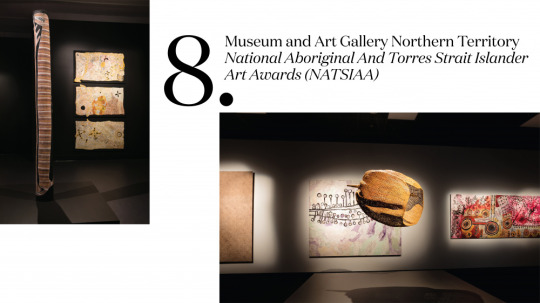
The 2020 finalists on display. Photo – Charlie Bliss.
National Aboriginal And Torres Strait Islander Art Awards (NATSIAA)
Museum and Art Gallery Northern Territory
The Telstra National Aboriginal And Torres Strait Islander Art Awards is a milestone event in the art calendar every year, and the 37th iteration will be no different!
The awards program and accompanying exhibition unites emerging and established Aboriginal and Torres Strait Islander artists at the Museum and Art Gallery Northern Territory in Darwin. The diversity of media displayed among the finalists in the last few years represents the richness of the contemporary art practices among leading Indigenous artists, and the fresh perspectives they bring to the artistic fabric of contemporary Australia. This show is knock-out every year.
Dates are yet to be finalised for this year’s program, but fingers crossed for an IRL ceremony and exhibition!
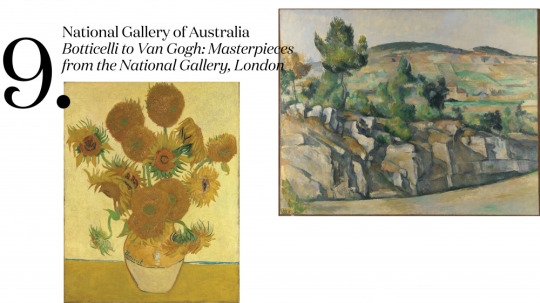
Left: ‘Sunflowers’ by Vincent van Gogh, 1888. Right: ‘Hillside in Provence’ by Paul Cézanne, c1890–92.

‘Four scenes from the early life of Saint Zenobius‘ by Sandro Botticelli, c1500.
Botticelli to Van Gogh: Masterpieces from the National Gallery, London
5 March – 14 June 2021
National Gallery of Australia
Hold onto your hats, there’s a masterpiece blockbuster on its way to Australia!
Spanning five centuries and seven key artistic periods, Botticelli to Van Gogh: Masterpieces from the National Gallery, London brings together 60 paintings by big time European heavyweights including Titian, Rembrandt, Vermeer, Velázquez, Goya, Turner, Renoir, Cézanne and Gauguin. These titans bookend Western European art history, starting with the Italian Renaissance and ending with the birth of modern art, catching the Dutch Golden Age, 17th-century Spanish movement and British portraiture in between.
This showstopper is presented in partnership with the National Gallery, London and is exclusive to the NGA.

The Green Room (Omega Project) by RONE, 2017.
RONE in Geelong
27th February – 16th May, 2021
Geelong Gallery
Rone is a longtime favourite in the TDF office, so just try and stop us from getting down to Geelong to see this!
From stencil works to archival photographs of his signature street murals and digital recreations of his installations, this is the first comprehensive solo survey of the artist’s iconic work. The exhibition culminates in a site-specific piece where one of the gallery’s rooms has been completely transformed into a RONE-style space.
The new multimedia commission will respond to the architecture and history of the building, reforming the grand reception area into a decayed and derelict room – reminiscent of his installations at the abandoned Burnham Beeches building in 2019. It will also contain a new soundtrack by composer Nick Batterham.
0 notes
Text
Glen on HubPages
Pirate Goats!3 months ago
I've been a hubber now for what, almost 6 years? Though I have been absent, missing in action even, for the last 12 months, and here I have popped up again, a self-described Children's Book Author. How did that happen?...
Zujava3 years ago
I'm not one to have all my eggs in one basket, that's why I like the fact that there are sites like Zujava around to complement my HubPage efforts.
Trackers - Episode III5 years ago
I've written two hubs on referrals and tracking. They're still worth reading, and you're probably better off reading them before you read this hub. This hub is less formal. I've often dished out advice on the forum,...
Spartacus - Blood and Sand3 months ago
Spartacus: Blood and Sand is a sword and sandal epic made for the small screen on a decent sized budget.
Shot in New Zealand (because it's cheaper than anywhere else), the majority of the cast being Australians...
Beans6 years ago
Bean is the common name for a number of pod-bearing plants of the pea family, particularly those belonging to the genus Phaseolus. Among the most widely cultivated beans are several varieties of kidney bean, including...
Pears6 years ago
Pears vary from green to yellow, flushed with pink, and may even be dark brown. They are second only to apples as an important commercial fruit.
Asparagus6 years ago
Asparagus was a favorite vegetable with the ancient romans, and still consumed widely today. possesses a perennial root and yields the edible stalks every spring. The young stems, or spears, of the asparagus plant are...
Ginger6 years ago
Ginger is a tropical perennial herb (Zingiber officinale) of the ginger family (Zingiberaceae), extensively grown for its aromatic rhizomes. It probably originated in tropical Asia and has long been cultivated in many...
URLs6 years ago
Uniform Resource Locator What is a URL? URL is just a fancy, though abbreviated way, of saying "website address". Typically speaking, when someone asks for a "website" they'll just give you the domain name, eg:...
New Zealand6 years ago
New Zealand is a country within the British Commonwealth, consisting of two large and several groups of smaller islands in the South Pacific Ocean. Located in the southwestern Pacific Ocean 1,900 km east of southern...
Three Steps to HubPages Success2 months ago
Using HubPages is as easy as 1, 2, 3. And I'll be giving three tips on each step. Here's what we'll be covering: 1. Three Suggestions... on how to write. 2. Three Ways... to make money. 3. Three Methods... to get...
The Facts About Nutrition6 years ago
To ensure healthy growth, an alert happy childhood and a vigorous healthy adult life, an efficient diet must be provided - efficient in the sense that it is balanced and of the right kind. What you eat influences how...
The Facts About Minerals6 years ago
Minerals are necessary for life and health. Some, such as calcium, magnesium, sodium and potassium are required in large amounts, while others are needed in much smaller quantities, and are therefore called trace...
The Facts About Vitamins6 years ago
At the beginning of this century a chain of discoveries were made, which could have changed the entire course of medicine, had we been ready for it. These were the discoveries of vitamins A, B and C. Vitamins are a...
Multimillion Dollar Home For Sale6 years ago
Imagine standing on the balcony at the top of a house and knowing that if you were to go over the railing and fell, you'd be dead. Okay, it's a gruesome start to a sales pitch but this is no ordinary house for sale. ...
Backlinking3 months ago
A backlink (also known as 'incoming links' or 'inbound links') is a link on a webpage, one you may own or usually somewhere else, that links to your target webpage or website. To contextualize it: at hubpages a...
How Did We Get Our Calendar?6 years ago
The calendar is a manmade system of dividing and measuring time. It involves the fixing of some definite era or point of time as a basis for reckoning (e.g: the Birth of Christ), and then the division of time into...
Adobe Photoshop6 years ago
The only limit is your creativity, imagination and talent. With Adobe Photoshop fantasy becomes reality, fiction appears to be fact and your dreams come to life in photo-quality images. From creating the surreal to...
Pirates & Piracy7 years ago
Piracy is as old as travel by sea. Pirates harried the commerce of Phoenicia, the world's first maritime nation, and piracy persisted into the middle of the 19th century when it rapidly declined as a continuous menace,...
Ticks7 years ago
All ticks are parasites, some of which transmit diseases to man and animals. Ticks differ from insects in having eight legs in the adult form. They have no wings but are often wind-borne to their hosts or else crawl up...
ASCII Art6 years ago
As early as 1867 typewriters have been used for creating visual art. In the late 70s and early 80s computers were limited in terms of graphics and via computer bulletin board systems of ASCII art became widespread. As...
Boer War7 years ago
Boers (from Dutch boer, farmer, husbandman), name given to the Dutch settlers in South Africa. They began to settle there in the 17th century and were augmented by some 200 Huguenots in 1688 and succeeding years, and...
The Fez18 months ago
The fez cap originates from Byzantine Greece. It was popularized by the military of the Ottoman Empire. It was quickly adopted by the Turks and was worn by many different religious and ethnic groups across Southern...
Monotremes7 years ago
Monotremes are egg-laying mammals of the sub-class Prototheria, the most primitive of living mammals. There are only two families, the duck-billed platypus of Australia and the spiny anteater (Echidna) of New Guinea and...
Knoji (the rip-off site formerly known as Factoidz)4 years ago
Things have changed at Factoidz. And it's now known as Knoji. The comments on this hub are most enlightening, I suggest you only skim through the information on this page (which reflect how Factoidz USED to work) and...
The Art and Science of Fencing7 years ago
Originally the art of attack and defense with sword or rapier in single combat, the word is now usually applied to friendly contests for sport with blunted weapons. The sword and buckler combats of Tudor times were...
Beards - They Grow On You!7 years ago
Beards have been worn from ancient to modern times and have gone through many changes in style, from neatly cut and closely trimmed to flowing and full. The beard is often associated with authority, as in the cases of...
The Complete Guide To Asterix7 years ago
The Complete Guide To Asterix by Peter Kessler is a must read for anyone who has picked ever picked up an Asterix book. It's sure to be enjoyed by both young and old Asterix fans. It gives an insight into the history...
Narcissism3 months ago
Narcissism is a psychological term used to denote fixation at an infantile emotional level. Although intellectually developed, the narcissistic person adopts a childish emotional attitude to life. Narcissism is a causal...
Genghis Khan7 years ago
At his birth Genghis Khan (born Temujin) the Mongols were a scattered nomad people feuding among themselves, and raiding Tatar settlements in northern China. Through alliances Temujin was able to dispose of rivals and...
Greek Philosopher: Epictetus7 years ago
Epictetus was one of the greatest of the Stoic philosophers. Born Phrygia, in Asia Minor, sometime between 50 to 55 AD. He became a slave in Rome, but (like many slaves at that time) he was given a liberal education. He...
Greek Philosopher: Carneades7 years ago
Carneades was an outstanding exponent of the philosophy of Skepticism. He founded the New Academy, a continuation
of the famous school of philosophy begun by Plato.
Greek Philosopher: Theophrastus7 years ago
Theophrastus studied under the great philosophers Plato and Aristotle. In 323 B.C. he succeeded Aristotle as head of the Peripatetic school of philosophy. Like Aristotle, Theophrastus was interested in natural...
Greek Philosopher: Xenocrates7 years ago
Xenocrates was Greek philosopher born around 396 BC in Chalcedon, Bithynia, Asia Minor. In 380 BC he migrated to Athens, where he studied philosophy under Plato and eventually presided over Plato's Academy from 339...
Nook: The World's Most Advanced eBook Reader7 years ago
Barnes & Noble have just announced the news of the release on 20th October of their eBook reader "Nook". Details are still a little light, but here's what I've learned so far in point form: Over one million titles...
Greek Philosopher: Zeno of Elea3 months ago
Zeno of Elea was a Greek philosopher born in Elea in southern Italy early in the 5th century BC. He was the favorite disciple of Parmenides, whom he accompanied to Athens in 448, and whose doctrine of the One he upheld...
Greek Philosopher: Zeno of Sidon7 years ago
Zeno of Sidon was a Greek philosopher. Born in Sidon, Phoenicia (now Lebanon) in around 150 B.C. He directed the Epicurean school at Athens after 100 B.C. and is known chiefly from the philosophical dialogues of Marcus...
Hubpages Works6 years ago
On the 12th of February 2009 I decided, finally, that publishing articles at HubPages would be far more profitable for me than publishing them elsewhere. It was never a question of me finding the time or the inspiration...
How InfoBarrel Works7 years ago
Much like HubPages, InfoBarrel is another site which allows you to publish content and splits the ad impressions with the author. In short, it's another way to make passive income online. If you're looking to not have...
Certificate IV in Training and Assessment (TAA40104)2 months ago
Vocational Education and Training (VET) means education and training for work. This training system recognises the knowledge and skills of learners across 6 different levels of qualification ranging from Certificate 1...
Apprenticeships7 years ago
An apprentice is a person who learns a craft or trade under the supervision of a skilled worker. An apprenticeship is the procedure by which young persons acquire the skills necessary to become proficient in a trade,...
Making Money from Jokes7 years ago
Heard a good joke lately? Or perhaps you've come up with a new one or added a twist to an old one. You've retold a jokes to family, friends or workmates and have been rewarded with a hearty laugh, snerk or chortle. ...
Fishing Techniques and Tips2 months ago
Since the earliest times, humans have hunted fish for food. The first flesh ever to be eaten, it has remained a popular and important item of our diet because of its delicate flavor and high protein content. The basic...
Spartacus3 months ago
The leader of a slave revolt in the first century BC, Spartacus and his followers seriously defied the power of Rome. The expansion of Rome in the centuries after the Punic Wars, together with the activities of pirates,...
How Do Deodorants Work?4 months ago
Perspiration is the moisture given off by the skin from activity of the sweat glands. The characteristic odor of sweat is caused by the breakdown, or decompostion, of the sweat by bacteria.
Deodorant antiperspirants...
Instant Coffee7 years ago
Instant coffee is cheap and it is convenient. It is produced by brewing coffee in a series of giant coffee pots. The extract moves from pot to pot until it reaches optimum strength. Then the water is removed, usually by...
Palm PDA's7 years ago
The Palm m515 was a handheld personal digital assistant released in 2002. It put a lot of power in the pockets of upwardly mobile users. People on the go had something compact, powerful, not to mention sleek, that...
The All Dumbbell Workout3 months ago
You can get a good workout at home. It's not so important WHERE you train, but THAT you train.
Buy free weights, collars and dumbbell handles long enough to accommodate a reasonable number of plates on each side of the...
Helium7 years ago
According to Alexa Helium.com has a traffic rank in the top 3000 websites on the Internet (2,747 at time of publication of this article). The average visitors sticks around for 6.4 minutes per day, and there are 2,620...
What is Nofollow?7 years ago
Early 2005 Google announced that hyperlinks (a clickable link to a webpage) with the rel="nofollow" attribute would not be counted as a backlink for the purposes of PageRank or influence the target sites ranking in the...
Tagging Your HubPages3 months ago
Choosing the right tags... Don't think about what others will use to try and find your hub, think about what YOU would use to find the same information that you have on your hub.
Puppets7 years ago
Puppets are small figures of wood or pasteboard, manipulated either by one hand (glove puppets) or by wires (marionettes) held by a concealed showman who also speaks the dialogue, changing his voice to suit different...
The Many Uses Of Cork7 years ago
Cork is the thick, spongy bark of the cork oak, a tree which grows mainly in Portugal and Spain. Half the world's supplies come from Portugal, where the cork oaks are grown either in plantations or in natural forests....
Dinghies7 years ago
A dinghy is a small sailing or rowing boat carried by ships or used by amateur yachtsmen, or a collapsible rubber boat carried by aircraft for emergencies. Dinghies range in length from 2 to 6 meters.
The Etruscans6 years ago
An ancient people inhabiting Etruria, Italy (modern day Tuscany) from the 8th to 4th centuries BC. At the height of their civilization, the Etruscans achieved great wealth and power from their maritime strength. The...
Early Rome7 years ago
Three influences - Greek, Etruscan and the local Italian cultures of Latium - were to shape the development of Rome. Later traditions attributed the foundation of the city to Romulus in 753 BC, but the true origins of...
The Republic of Rome3 months ago
In the 500 or so years from the establishment of the republic to the accession of Augustus, Rome grew from a small city-state to the dominant power in the Mediterranean. This process, which was achieved by both military...
Roman Emperor - Magnus Maximus7 years ago
Born in Spain. Maximus proclaimed himself emperor while commanding Roman troops in Britain, defated Emperor Gratian in Gaul (383), and was recognized by Theodosius, emperor of the East. Invading Italy, his troopers were...
Roman Emperor: Theodosius I7 years ago
Theodosius I, or Flavius Theodosius, known as the Great, Byzantine Emperor, son of Theodosius, general of Valentinian I. He was proclaimed emperor of the East by Gratian in 379 and established Christianity throughout...
What are Aqueducts?7 years ago
An aqueduct is a bridge constructed for the conveyance of water across a valley. Civilization has always resulted in the growth of large towns which cannot exist without adequate water supply, and traces of extensive...
Tasmanian Tiger5 years ago
The Thylacinus cynocephalus is the largest known marsupial carnivore. Records indicate that a thylacine female could give birth to four puppies each year and these spent their early life in a backward-facing pouch. The...
Emu7 years ago
Together with cassowaries, the large, flightless birds known as emus make up the order Casuariiformes. They are found throughout mainland Australia, except the dense, tropical regions of the eastern coast and the more...
Echidna7 years ago
The echidna, also called the spiny anteater, is a an unusual mammal native to Australia and New Guinea. The echidna ranges in length from 15 to 30 inches (38 to 76 cm) and weighs from 2 to 14 pounds (0.9 to 6 kg). It...
Tasmanian Devil7 years ago
Like its relative, the Tasmanian Tiger, the Tasmanian Devil once also lived on mainland Australia but is thought to have died out there because of the competition from the Dingo. The Tasmanian Devil is a short and...
Dingo7 years ago
Sometimes known as the Warrigal, the Australian Dingo, Canis familiaris dingo, is closely related to the domestic dog. It is probably descended from the northern wolf, and is thought to have been introduced to Australia...
Cassowary7 years ago
Cassowaries are large flightless birds found in tropical rainforests of New Guinea. One species is also present on Cape York, Peninsula, Australia. The head of the cassowary is protected by a natural crash helmet, a...
Lyrebird7 years ago
Lyrebirds are an Australian bird, pheasant-like in appearance, known for its spectacular song and their remarkable use of mimicry Their ability to learn and reproduce a wide variety of complex sounds is all the more...
Wombat7 years ago
Resembling a small bear, the wombat is from a small group of burrowing mammals, native to Australia. Their stocky body ranges in length from 40 to 60 inches (100-150 cm), and their coarse hair varies from black to...
Wallaby7 years ago
There are about 30 species of wallaby. They are kangaroo-like marsupials of generally smaller size than the true kangaroos, of the subfamily Macropodinae of the family Macropodidae which also includes the kangaroos. The...
Platypus7 years ago
This remarkable, egg-laying mammal is found in streams and rivers of eastern Australia. It lives in a burrow near the water, feeding on water insects, worms and freshwater prawns and crayfish. Platypusses were at one...
Bandicoot7 years ago
Bandicoot, a burrowing nocturnal marsupial, the largest kind about the size of a rabbit. Several species inhabit Australia, New Guinea and adjacent islands, one of the commonest being the short-nosed bandicoot.
Kookaburra5 years ago
A kookaburra is a large meat-eating Australian bird. Although a member of the kingfisher family, appears very drab when compared with its brilliantly colored relatives. It has a loud, harsh cry like wild laughter and is...
Goanna6 years ago
Goanna, large lizards of the genus Varanus, known more formally as Monitor Lizards. The name 'goanna' is a corruption of "iguana", given in the early days of Australian settlement because of a superficial resemblance to...
Kangaroos6 years ago
The kangaroo is a large marsupial (pouch-bearing animal) confined entirely to Australasia. Captain Cook was the first Eurpoean to observe the animal in 1770. There are 56 species. A male kangaroo stands from 6 to 7...
Koalas5 years ago
A koala is a tree-dwelling Australian animal. It feeds on leaves and roots, and is not more than 2 foot in length. It has round bushy ears and thick ashy-grey fur, a rudimentary tail, and looks like a small bear....
Google Knol3 years ago
Knol is a user generated content platform that allows members to publish online and also make money from an advertising revenue program.
Boat Anchors7 years ago
An anchor is a heavy implement, usually made of iron or steel, with hooks or flukes to grip the bottom, attached to a cable and dropped from a ship or boat to hold it in place.
7 Things You Probably Didn't Know About Potassium7 years ago
Potassium is a metal belonging to the alkaline group which is an essential constituent of body cells and tissues. Some of its salts are used for medicinal purposes and in action are similar to those of sodium. As...
Muscle & Fitness5 years ago
Your reasons for including weight training in your weekly schedule will largely determine the type of program you follow and the exercises to be included. There is an endless variety to choose from and it is therefore...
Serratus: Paying Attention To Detail5 years ago
The serratus is a set of muscles, which connects the lats, pectorals, intercostals, and external obliques. The serratus muscles are occasionally called the "boxer's muscle" because it is used to extend the arm and...
Obliques & Intercostals5 years ago
Left unattended and ignored (and downright neglected) the obliques will ally themselves with the equally slothful abdominals to result in a what is known as a 'beer gut'. While the abdominal may do all the work for said...
Strong Neck and Impressive Traps5 years ago
You may not consider your neck the most important body part to
concentrate on in the gym, but you have at least three important
reasons to work it. 1) your neck muscles are responsible for
your head movements, 2)...
Building a Broader Back5 years ago
The latissimus dorsi (aka The Lats) is responsible for extension, transverse extension, flexion, adduction and internal rotation actions of the shoulder joint. The action of the lats draws the upper arm downward and...
Gladiators2 months ago
Professional fighters in ancient Rome were called gladiators (from the Latin gladius, meaning 'sword'). Contests between gladiators were held in special arenas and were a very popular form of public entertainment.
What is HubberScore?5 years ago
There are two types of scoring on HubPages. One is for the individual hub, which you can learn more about here, and the other is the score for the person. The Author. The Hubber. Yes, you. This hub is all about that...
HTML Tutorial7 years ago
Ever wondered what it takes to create a webpage in HTML? Ever wanted to understand the mess of source code that magically becomes said webpage on the world wide web? You can, right now. This short lesson will dispel any...
Flatten Your Stomach And Chisel Those Abs5 years ago
Photos by Scott Snyder and Thom Wall Let's face it, the way your midsection looks has a lot to do with how
you feel about yourself. Everybody desires washboard abs, or in the
very least a flat tummy. A small tight...
Strengthen Your Lower Back5 years ago
A strong back has long been admired and desired as the basis of power. The main concern of both athletes and non-athletes alike is lower back pain. One way to avoid or alleviate it is to strengthen all the muscles of...
Roman Emperor - Julian7 years ago
Flavius Claudius Julianus, born around 331 A.D. in Constantinople (now Istanbul, Turkey) the youngest son of Julius Constantius and Basilina, and nephew of Constantine the Great. He was brought up a Christian but early...
Roman Emperor - Diocletian7 years ago
The emperor Diocletian (245 - 313 AD) was responsible for restoring stability to the Roman Empire after decades of anarchy. He is remembered for the reorganisation of the Roman army and the administration of the empire....
Celebrating Useless Keyword Victories2 months ago
My first foray online was 13 years ago. It was 1996... it was on a friends computer... it was love at first 'site'. Over the ensuing months I'd get a taste of it now and then when I visited his place. It didn't sate my...
HubPage Fans5 years ago
Fans are your followers. Your subscribed audience. They have deliberately clicked on a link in your profile or on one of your hubs that says "Join such-and-such's fan club". 'Such-and-such' being your username of...
Scones3 months ago
For a really traditional Devonshire tea you can't beat warm, freshly baked scones split open and served with fruity jam and lots of whipped cream.
Roman Philosopher - Seneca18 months ago
Great Roman philosopher, politician and writer, who was tutor to the emperor Nero. Seneca's fame rests upon his writings. They have been variously estimated by critics, but all agree as to their clear and forcible...
Roman Emperor - Constantine I7 years ago
Constantine the Great, born Flavius Valerius Constantinus, at Naissus, in Upper Moesia (now Nish, Yugoslavia), 272 A.D. He was the illegitimate son of Emperor Constantius I and his mother was Flavia Helena. On his...
Get a Firmer Butt!5 years ago
Who doesn't like a nice looking butt? Who doesn't mind LOOKING at a nice butt?
If you don't want your backside looking like two pigs fighting over milk duds, then you need to work out that muscle with the extravagant...
Explosive Quadricep Power!5 years ago
The major muscles of the upper leg include the gluteus maximus, the sartorius, the quadriceps, and the hamstring muscles. The quadriceps is composed of four muscles that cover the front of the thigh. Their major...
Develop Firm Hamstrings5 years ago
The hamstring muscles are three large muscles at the back of the thigh. They are important in bending the knee and also serve to rotate the leg from side to side. They are attached to the tibia by certain tendons,...
Roman Dictator: Lucius Cornelius Sulla7 years ago
Roman general and politician, a leader of the senatorial party. Forcibly suppressing the democrats in 88BC, he departed for a successful campaign against Mithridates VI of Pontus. The democrats seized power in his...
Welding5 years ago
Welding was originally the term applied to the joining of pieces of metal by hammering or pressing them together when hot. It is now also, and more particularly, applied to processes in which the edges to be joined are...
Shapely Calf Muscles5 years ago
The major calf muscles are the gastrocnemius and soleus. These two, combined with the deep posterior muscles, the peroneus brevis, flexor longus hallucis, tibialis posticus and flexor longus digitorum and the anterior...
What is HTML?3 months ago
HTML is an acronym of Hyper Text Markup Language. If you were to look at a page of HTML source code (pages which use the file extension .html or .htm), even if you are unfamiliar with HTML, you should be able to...
Forearm Fitness5 years ago
Your hands, wrists and forearms are usually on intimate terms with the instruments of your sport. You need a powerful set of muscles there to execute a winning swing with a racquet, bat or golf club, to spike or slam...
Build Solid Shoulders5 years ago
The broad-shouldered, narrow-hipped look is the very symbol of a fit and trim body. But the V-shaped torso you want isn't just for good looks. Your shoulder joints are the key to just about any arm action you'll ever...
Achieving a Thicker Chest5 years ago
A powerful chest is one of the most desirable elements of an overall fit body. It's the centerpiece of your physique, and well-shaped and toned muscles up front are important for that bare-chested day at the beach, as...
Training Terrific Triceps5 years ago
One of the major muscles of the arm, the triceps, acts to extend or straighten the arm (while the biceps perform the opposite motion, flexing). The muscle runs from the shoulder to the elbow at the back. It is named for...
Big Bulging Biceps5 years ago
At the front of the upper arm is the biceps, a large muscle that draws up the arm when it contracts. It also enables the palm to be turned upward. At the back of the upper arm is another large muscle, the triceps, which...
Sparta7 years ago
In almost every respect, Sparta was the opposite of her great rival, Athens. Whereas Athens was a democratic state, Sparta was a military society, racially pure and elitist in character. At the height of their power,...
The Wonderful World of Cheese!7 years ago
Cheese is a nutritious dairy product usually made from the curd of milk. Since it was first made some 3,000+ years ago, cheese has been an important food in the diet of many peoples. Cheese was one of the earliest foods...
HubPages Traffic Bonus2 months ago
I have 30 days in which to get as much traffic from as many different sources as I can to qualify for the HubPages "Traffic Bonus". I'll be outlining here what steps I'm taking to achieve that goal. The criteria is...
Capstone Hub Program3 months ago
Capstone Hubs: What are they, how can I get approval, when can I get started?
Flagship Hub Program2 months ago
Having published 3 Flagship Hubs I feel competent enough to share some insights as well as a few tips and tricks. I haven't done a Flagship Hub in a while, but that would be because I've been busy making Capstone Hubs. ...
Pepe The King Prawn3 months ago
Pepe the Prawn is one of the Muppets. He was first introduced in the 1996 TV show Muppets Tonight. At the time, he would sing along with his partner, Seymour the Elephant, although neither of the two had any real...
Caricature: Why, When, What and Where Did It Come From?7 years ago
Caricature is the pictorial equivalent of satire, whereby flaws in society are attacked with the weapon of ridicule. Striking images are drawn by simplifying, distorting, exaggerating and careful juxtaposing.
Newcastle, Australia7 years ago
City seaport of New South Wales, Australia, at the mouth of the Hunter River 167 km north of Sydney. Founded in 1801, Newcastle owes its position and importance to the presence in the area of large coal deposits, which...
The Roman Empire3 months ago
The period which Rome controlled most of the Mediterranean world is known as the Roman Empire. The term empire refers to both the extent of Rome's territories and the type of rule.
The length of time and vastness of...
Innuendo5 years ago
Innuendo is a figure of speech in which meaning is conveyed by a hint. In English law, innuendo means that the words or gestures complained of, although not defmatory in their ordinary or natural meaning, are, in...
The History of Playing Cards18 months ago
Playing cards are made of thin pieces of pasteboard or plastic in uniform sizes by decks. The cards are usually rectangular with rounded corners, although earlier cards were sometimes square or circular. Cards are...
Roman Emperor - Marcus Aurelius3 months ago
Marcus Aurelius has symbolised, for many generations, the Golden Age of the Roman Empire. A conscientious and self-sacrificing emperor, his claim to the attention of subsequent ages has been greater because, with the...
Roman Emperor - Commodus3 months ago
Lucius Aelius Aurelius Commodus, was born at Lanuvium on 31 August 161 AD. The son of Emperor Marcus Aurelius, whom he succeeded in 180. Commodus was only 18 when he became emperor. And turned into a cruel tyrant.
Roman Emperor - Aurelian5 years ago
Aurelian was born Lucius Domitius Aurelianus, probably in Illyricum (now Yugoslavia). A successful soldier, he was chosen emperor by his troops on the death of Claudius II. He became emperor in 270 and ruled until 275,...
Roman Emperor - Septimius Severus5 years ago
The only African born Roman citizen to become emperor. Born in Leptis Magna in North Africa (Libya) in 146 AD Lucius Septimius Severus, rose to promenience and reigned as emperor from 193 AD to 211 AD.
Roman Emperor - Hadrian3 months ago
Hadrian's official name was Publius Aelius Hadrian. He was born in Spain. His father died during Hadrian's youth, and Trajan, Hadrian's cousin, became his guardian. Trajan became emperor in 98. Hadrian became emperor...
Roman Emperor - Trajan5 years ago
The Roman emperor Trajan was important for extending the empire's frontiers to include Armenia, Dacia and also Mesopotamia. Many scenes from the emperor's campaign in Dacia are recorded on Trajan's column in Rome, the...
Roman Emperor - Domitian18 months ago
Domitian succeeded Titus, his elder brother, as emperor in 81 AD. The early part of Domitian's reign was marked by good government, but he soon adopted cruel and tyrannical measures.
Malayan Tapir3 months ago
The Malayan or Asiatic tapir is strikingly patterned with the foreparts and the limbs black and the rest of the body white, making it inconspicuous in its native habitat. Completely black individuals have been recorded...
Mountain Tapir3 months ago
The Mountain, Roulin's or Woofly Tapir (Tapirus pinchaque) is easily distinguishable from the South American by its curly black hair, sometimes over an inch long, and its light cheeks and strongly marked white ear-rims....
Brazilian Tapir3 months ago
The Brazilian, South American or Lowland tapir (Tapirus terrestris) is
the smallest species and the heaviest individuals weigh only 400 pounds
(180 kg). It is plain brown, often with whitish lips and ear-tips, and
grey...
Baird's Tapir3 months ago
The last and the largest of the New World group, is Baird's tapir T. bairdii, which weighs 600 pounds (270 kg).
This species is short-haired like the South American, with very small bristles along the nape as a...
Sydney Opera House18 months ago
The Sydney Opera House, at Bennelong Point on Sydney Harbour, caters for all the performing arts and is one of the world's most unusual buildings. It was designed by the Danish architect Joern Utzon and was opened by...
Boobies3 years ago
Booby is a name applied to six species of the gannet family that are confined to the tropical regions. It is derived from the Spanish 'bobo' meaning dunce. This is an allusion to their clumsiness on land and their lack...
Roman Emperor - Titus5 years ago
Roman emperor from AD 79. Eldest son of Vespasian, he captured Jerusalem in 70 AD to end the Jewish revolt in Roman Palestine. He completed the Colosseum, and helped mitigate the suffering from the eruption of Vesuvius...
Roman Emperor - Vespasian3 months ago
Born near Reaste, a city northeast of Rome. His full name was Titus Flavius Vespasianus. He became a general and in 67 AD Emperor Nero sent him to put down a Jewish rebellion in Judea. During the year after Nero's death...
Ancient Greek Trireme4 years ago
The trireme is an ancient vessel with three rows of oars, of great effectuality, in early naval warfare. Mentioned by Thucydides. It was a long narrow vessel propelled by 170 rowers. The Romans copied it from the...
Roman Emperor - Claudius5 years ago
Roman emperor from 41 AD to 54 AD. Claudius was a scholar, historian and able administrator. One of the greatest of the early Roman emperors. He was made emperor by the Praetorian Guard after the murder of his nephew,...
Roman Emperor - Tiberius5 years ago
Tiberius, Roman emperor from 14 AD to 37 AD. Born Rome, Italy, 16 November 42 BC.
The son of Tiberius Claudius Drusus and Livia Drusilla who in 39 BC divorced her husband to become the wife of Augustus. Tiberius and...
Roman Emperor - Caligula18 months ago
Roman emperor, son of Germanicus and successor to Tiberius in AD 37. Caligula was a cruel tyrant and was assassinated by an officer of his guard. He is believed to have been mentally unstable.
Roman Emperor - Augustus3 months ago
The Roman Republic ended with Julius Caesar and the Roman Empire began with Augustus Caesar.
Augustus, the title originally conferred by the Roman senate in 27 B.C. upon Gaius Octavianus, the successor of Julius...
Roman Statesman - Marcus Tullius Cicero3 months ago
Marcus Tullius Cicero, a leading politician and Rome's greatest orator, achieved a mastery of prose style that is unsurpassed by any other writer in Latin literature.
Roman Emperor - Nero5 years ago
Born at Antium, his original name was Lucius Domitius Ahenobarbus; but in AD 50 his mother married her uncle, the emperor Claudius, who adopted and renamed him. In 53, at the age of 16, Nero married Octavia, daughter of...
Greek Philosopher: Leucippus8 years ago
Leucippus was a Greek philosopher and a pupil of Zeno of Elea, probably born in Abdera (though some have said Elea, and others say at Miletus). Virtually nothing is known of his life (hence this hub being so short) and...
Dactylography: The Scientific Study of Fingerprints11 days ago
Fingerprints are an excellent means of identifying people because each individual's fingerprints are unique and remain unchanged during their lifetime.
Greek Philosopher: Xenophanes7 years ago
Xenophanes, a native of Colophon in Asia Minor, the son of Dexius. According to some he was no man's pupil, according to others he was a pupil of Boton of Athens. Since Xenophanes' was a wandering poet and a maker of...
Greek Philosopher: Anaximenes8 years ago
Anaximenes was an early Greek philosopher who lived in the 500's B.C. Like other philosophers of his time, he believed that there is a single substance underlying all things. Unlike the others, Anaximenes believed...
Galileo Galilei7 years ago
An controversial and intellectually courageous character, Galileo Galilei (1564-1642) is recognised as the founder of modern 'scientific method', which he insisted should replace the Aristotelian philosophy prevalent...
The Lathe18 months ago
A device for cutting metal, wood or other material into a circular shape. The object to be 'turned' or shaped is revolved by the machine; and a cutting tool, firmly supported, is brought up against it. Lathes are of...
The Stethoscope8 years ago
Before the development of the stethoscope, doctors placed their ears directly on the patient's body so the action of the heart and other organs of the chest can be heard and gauged. That was soon to change when French...
Matches6 years ago
A match is a small thin stick of wood or cardboard. Its tip is coated with chemicals that produce a flame easily when it is rubbed sharply against a rough surface. Matches tipped with an explosive substance that...
Roman Dictator - Julius Caesar3 months ago
Gaius Julius Caesar was a Roman statesman and one of the world's greatest military commanders. Caesar dominated the history of Rome during the final years of the republic.
Hippocrates7 years ago
Hippocrates was a Greek physician who lived around 400 BC, born on the island of Cos, Asia Minor. Historically known as the "father of medicine". Little is known concerning him, and of that little, much may be legend....
Themistocles8 years ago
Athenian solder and politician. Largely through his success in persuading the Athenians to build a navy, Greece was saved from Persian conquest. He fought with distinction in the Battle of Salamis in 480 BC during the...
Galen5 years ago
A famous physician born in Pergamum; practiced with great success in Rome, being medical adviser to the Emperor Marcus Aurelius and his colleague Lucius Verus. Claudius Galenus (Galen) was born in Pergamum in Asia...
Greek Philosophy6 years ago
Philosophy is the study of the truth or principles underlying all knowledge, an investigation into the nature of reality. The word 'philosophy' derives from the Greek philosophos which means "a lover of wisdom. ...
Opals6 years ago
An opal is a noncrystalline variety of quartz, found in recent volcanoes, deposits from hot springs, and sediments. Usually colorless or white with a rainbow of play of color gem forms, most valuable of quartz gems.
Master Craftsman: Antonio Stradivari8 years ago
Antonio Stradivari (1644 - 1737) was an Italian maker of violins. He was one of the leading instrument makers in music history. He used Stradivarius, the Latin form of his name, on the labels of his instruments. A pupil...
Tattooing: What, Where, When and Why4 years ago
Tattooing is the process of injecting a permanent dye under the skin to form a picture or design is called tattooing. The word 'tattoo' derives from a similar sounding word in the Polynesian language. Tattooing was...
Copyright7 years ago
Copyright is the sole legal right of multiplying copies of an original work or composition; literary, dramatic, musical or artistic work. It grants the copyright holder (usually the author of the work, unless they've...
Greek Philosopher: Thales6 years ago
Thales (634 B.C. to 546 B.C.) was the first known Greek philosopher and scientist. Traditionally known as the father of philosophy, he also invented theoretical geometry and abstract astronomy and was the first of the...
Greek Philosopher: Plotinus8 years ago
Roman philosopher of the Neoplatonic school, born in Asyut, Egypt. Plotinus lived from 205 to 270 AD in Alexandria. He studied with the Alexandrian philosopher Ammonius Saccas at Alexandria for a period of ten years...
Greek Philosopher: Anaximander7 years ago
The son of Praxiades. He was the first discoverer of the gnomon (the part of a sundial that casts the shadow) and he placed some in Lacadaemon on the sundials there. He was the first person to draw a map of the earth...
Greek Philosopher: Anaxagoras7 years ago
Anaxagoras was a famous Greek philosopher and noted scientist of the Ionic School, among whose pupils were Socrates, Pericles and Euripides. According to his explanation of the universe, the permanent elements of...
Greek Philosopher: Empedocles3 months ago
The Greek philosopher Empedocles tried to harmonize the Eleatic concept of permanent being with the Heraclitean teaching of constant flux. Teaching the doctrine of the four elements: earth, water, air, and fire, he...
Greek Philosopher: Pyrrho6 years ago
A system of skeptic philosophy taught by Pyrrho of Elis founder of Pyrrhonian school, holding that nothing can be certainly known and that suspension of judgement is true wisdom and the source of happiness. Its central...
Greek Philosopher: Heraclitus7 years ago
Heraclitus was an early famous Greek philosopher, and a leading member of the so-called pre-Socratics. He was a descendant of the royal line of his native city and it is probably that he help temporal and religous...
Greek Philosopher: Antisthenes3 months ago
Greek philosopher, founder of the school of philosophy called Cynicism. He was born in Athens and became a disciple of Socrates. Antisthenes taught in the gymnasium known as the Cynosarges outside Athens; his...
Greek Philosopher: Protagoras7 years ago
The most famous Greek philosopher before Socrates, who was a younger contemporary. Protagoras sought to teach men virtue in their daily lives, and summed up the basis of his own philosophy in the maxin 'Man is the...
Greek Philosopher: Parmenides3 months ago
Greek philosopher of Elea, founder of the Eleatic school which believed in unity and continuity of being and unreality of change or motion. Parmenides was the son of Pyres and a native of Elea. Plato, in the...
Fun HubPages FAQs7 years ago
HubPages was actually started BEFORE the internet was invented. Unfortunately it proved to be too impractical to get HubScore to work properly with the cork board and thumbtacked notes. The development of the...
Greek Philosopher: Zeno of Citium3 months ago
Zeno was the founder of Stoic philosophy in Athens. He was born in Citium on the island of Cyprus. It is reported that he was originally a merchant, but was shipwrecked and lost all his property traveling to Athens in...
Greek Philosopher: Xenophon3 months ago
Xenophon was a Greek historian, soldier, essayist and philosopher. A pupil of Socrates. In 401 he joined the Greek mercenary army in an expedition of Persian prince Cyrus against Artaxerxes, and was elected one of the...
Greek Philosopher: Pythagoras7 years ago
Greek mathematican and philosopher, best known for his discovery that the square of the hypotenuse of a right angled triangle is equal to the sum of the squares of the other two sides. Greek philosopher and...
Greek Philosopher: Diogenes3 months ago
The celebrated Greek cynic philosopher who is said to have lived in a tub, wearing the coarsest clothing and living on the plainest food. Many of his sayings have been preseved, and serve for occasional quotation. ...
Greek Philosopher: Democritus5 years ago
The Greek philosopher to whom the conception of the Atomic theory is attributed. He visualised atoms - the word is Greek for 'indivisable' - as moving through space, then colliding to form the universe and all natural...
Greek Philosopher: Epicurus3 months ago
Epicurus was a Greek philosopher, founder of the Epicurean school. Although only fragments of his works remain, his loyal disciples passed on his doctrines of friendship, peace of mind, and spiritual enjoyment as goals...
The Ten Principles of Feeding a Horse7 years ago
1. Nowadays most horses, particularly heavy horses, are underworked. Or
even idle. Therefore their greatest peril is overfeeding. The worst
enemy of an idle horse is fodder which would be suitable to him if he
were...
Atari18 months ago
Atari is a corporate and brand name owned by several companies since its inception in 1972. The computer entertainment industry from the 70s to the mid 80s was defined the likes of Pong and the Atari 2600, as Atari...
Hot Sexy Sandra Sully6 years ago
What is this fascination with some Hubbers and publishing hubs with very little content and a LOT of images of bikini clad babes? Okay, I know that sex sells, but are they actually getting traffic? Is it well worth the...
Greek Philosopher: Plato7 years ago
Born at Athens of a noble family, he intended to enter politics but was disgusted with Athenian political intrigue and disillusioned with the democratic regime. He became a disciple of Socrates and was present at his...
The Philosophy of Socrates6 years ago
Born in Athens at the peak of the Athenian civilization. Aeschylus, Sophocles and Euripides were his contemporaries. He served for several years as a soldier. As a member of the Athenian Senate, he refused to connive in...
The Avocado3 months ago
An evergreen tree of the laurel family that bears a pulpy edible fruit. Avocados are a thick-skinned tropical fruit, often served at the beginning of a meal or in a salad. The flavor is an acquired taste amd the fruit...
Tapir7 years ago
Stoutly build, hoofed mammal of South America and Malaysia. Tapirs have a rounded body covered with bristly hair like that of a pig, about the size of donkeys, with shorter legs and heavier bodies. They have a long...
Greek Philosopher: Aristotle7 years ago
Aristotle the most famous of all the Greek philosophers, was a disciple of Plato, after whose death he retired from Athens, and later undertook the education of Alexander, later known as Alexander the Great....
Michelangelo8 years ago
Renowned Italian painter, sculptor and architect, whose genius was such a power in beautifying the churches of Rome and Florence. Was the last and in some respects the greatest of the Italian sculptors; while his large...
The Unofficial Rules for HubPages6 years ago
I'm just a loyal and active Hubber, who probably pays more attention than most to what's being said on the forums. The evidence of this can be seen on my HubScore hub. I say that this hub is unofficial, because I am...
Table of Contents7 years ago
I'll probably write this and then the powers-that-be will create a Capsule to do in a few seconds what may take a while to create. Which is fine by me! I wish there was such a capsule! But in the meantime you can...
Duplication vs Plagiarism6 years ago
There seems to be some confusion, especially in the community here at HubPages, as to what duplication really is. And to be quite honest, when you look at all the facts it can become quite confusing. All...
How Hubscore Works3 months ago
All this information is available around HubPages, in the FAQ or in some cases discussed further in the forum. But rather than send you off on a wild goose chase to find it all I've collated the information to present...
Pimp My Clyde18 months ago
Forget new rims and low profile tyres, we're talking low-tech old-school. And while its lacking the bling factor it takes highly specialized skills to take care of these one horse-powered beasts.
Working and show...
Free Antivirus Software3 months ago
Cool Fonts - Where to Download & How to Install3 months ago
There are two types of fonts in the world: free ones and ones you have to pay for. And while on one hand you get what you pay for (quality in ways you can't understand until you need a full font set), on the other...
How Wine Is Made3 months ago
It starts with the grape. But not just any grape. A carefully and specifically chosen grape whose vine will complement the soil and the climate. At Telegherry they've chosen the Pinot Gris. But they grafted a...
Kindle4 years ago
It feels more like a book than an electronic device. It reads like a book but with the ability to hold over 200 titles on a device that weighs less than a McDonalds Quarter Pounder. It's the new Amazon Kindle. ...
Punctuation Is Your Friend8 years ago
Punctuation marks are special signs (e.g: full stops, commas, exclamation points) which help you understand what you're reading. When you read out loud they also show you where to pause and when to raise or lower...
Capsules4 years ago
Metaphorically speaking, they are the tools in your toolbox. They are building blocks. You pick and choose the ones you need to build the hub you want.
There are two types of capsules:
Content Capsules
Text...
How HubPage Tracking Works6 years ago
If you haven't read it already I suggest you check out the light introduction to HubPage Referrals. It's a quick read and outlines the basics. Referrals work in two ways... 1) If someone signs up for a HubPages...
An Introduction To HubPage Referrals6 years ago
A referral is either: a) Being a HubPage Author and referring a visitor to sign up to HubPages to become an author. Or, b) Referring traffic to another HubPage Authors hub. a) If someone signs up for a HubPages...
Hubpages vs Squidoo3 months ago
If you're a Hubber you may have heard of Squidoo. What is the fuss all about? This hub is a close look at Squidoo, how it works and what's in it for you, looking from the viewpoint of a Hub Author. Squidoo is...
Apocalyptica18 months ago
Classical strings meets heavy metal, headbanging cellists rock out with symphonic riffs. From Metallica to their own original compositions, Apocalyptica is one of the most distinctive bands in the world. They started...
Birth of the feature length film3 months ago
At an unprecedented 70 minutes The Story of the Kelly Gang is regarded as the world's first feature length film. It premiered at the Athaneum Hall in Melbourne (Australia) on the 26th December 1906. Written and...
Fuel - Hemorrhage (In My Hands)7 years ago
The song Shimmer by Fuel was the one that heralded the arrival of the band to the music listening public back in 1998. But it wasn't until Hemorrhage (In My Hands) from their 2000 album Something Like Human that Fuel...
0 notes
Text
Rio de Janeiro: Insider Travel Guide
(CNN)Travel fantasies don’t always live up to the reality, but the “marvelous city,” as Rio de Janeiro’s citizens call their beloved hometown, can knock even the most jaded travelers off their seen-it-all perches.
Dress appropriately, it can get extremely hot in Rio.
Famed for girls from Ipanema and Carnaval, the best of Rio is all that but a lot more.
The party goes on year-round in the cultural heart of Brazil, from the samba renaissance in the Lapa District, where you can choose from an array of great clubs, music and restaurants, to Carnaval rehearsals at local samba schools that redefine the word “celebration.”
The best of Rio beaches of the Zona Sul are heavily patrolled and many other areas — especially those troubled by crime and drugs — have been cleaned up, but you do need to exercise caution.
Don’t flash iPhones and money, don’t take more cash with you than you can afford to lose and use taxis at night called by your hotel to take you to the doorstep of your destination.
Mostly Rio specializes in merrymakers who bring you into the fold. Whether it’s hanging out over caipirinhas at a neighborhood bar, hiking in the rainforest or dancing in a circle of samba at an old dancehall, Rio is a realm of the senses, some of which you may find have been AWOL for a while.
Hotels
Luxury
Copacabana Palace
Like a glistening casino in Monte Carlo, the massive white edifice of the Copacabana Palace looms above the beach strip of Avenida Atlantica.
The most storied hotel in Rio, the Copacabana opened its doors in 1923 as a roost for dignitaries and diplomats.
The 1933 film “Flying Down to Rio,” set at the Palace but filmed in Hollywood, made it a hangout for celebs.
Orson Welles trashed his room here following a fight with Dolores del Rio, as did Ava Gardner after Sinatra dumped her.
The furniture doesn’t fly like it used to, but this best of Rio hotel still brings in the royals and their modern counterparts — rock stars.
It’ll set you back a bit for a stay in one of the 245 rooms, but you won’t complain about the impeccable staff or features such as “Juliet balconies” (in some rooms), spacious rooms and classic furniture. More recently constructed rooms with city views are located in the Tower Wing building.
Porto Bay Rio Internacional Hotel
The Porto Bay Rio gives you a resort-style experience in the heart of beachfront row Avenida Atlantica.
The modern, upscale facility pulls out all the stops, from luxurious rooms to fine dining and views up and down the world’s most famous beach.
The rooftop Bossa Lounge lets you knock back caipirinhas to the sound of bossa nova as you gaze from white sands to jungled slopes and the statue of Christ the Redeemer atop Corcovado. It’s a good place to slap yourself to see if you’re dreaming.
It would be hard to find a more panoramic view of Copacabana, Sugarloaf and Copacabana Bay than from the 20th-floor pool unless you’re operating a drone.
The rates aren’t cheap but good value for luxury with the declining value of the Brazilian real.
Mid-range
Mar Ipanema
This stylish boutique hotel has a primo locale, just five minutes from Ipanema Beach and a few blocks from the Rodrigo Freitas Lagoon.
The hippest beach hangouts are minutes away, as are a host of the city’s most happening boutiques, restaurants and bars in one of the safest neighborhoods in Rio.
The upscale Leblon district is a five-minute walk.
Mar Ipanema rooms feature tasteful dcor accented by Rio motifs that feel custom-crafted.
Wi-Fi is available in all rooms.
The one downside: you have to use the restaurant next door for dining. Room rates are below most in the neighborhood.
Budget
Rio Panoramic Hotel
The coastal views are not all in Copacabana. The other side of Sugarloaf and its bay filled with sailboats are also stunning.
Perched on a hill overlooking Botafogo Bay in the artistic and quaint Santa Teresa neighborhood, the Panoramic gives you a view of the city below and a vista of islands and Sugarloaf lining the bay.
The renovated Art Deco villa earns great reviews among Rio lodgings, averaging five stars on TripAdvisor.
This B&B was originally the home of a doctor, and it has been lovingly restored to bring the personal touch to its six well-appointed and air-conditioned rooms.
There’s a pool, breakfast in the garden and staff on site to offer tips on the attractions and shopping nearby.
Hotel Novo Mundo
Built in 1950, this three-star hotel has been a favorite of Brazilians over the years for its prices, views and proximity to Santos Dumont airport, the terminal for domestic flights.
Soccer great Pele used to stay here when he had a game in Rio.
The hotel is located at Flamengo Beach, a coastal stretch as scenic as the Zona Sul, but often overlooked by travelers.
Flamengo Park, a long stretch of green that parallels the coast, is across the street. Outside are great views of Sugarloaf and Guanabara Bay. The metro is a block away.
A stay on this side of Rio puts you closer to the action downtown, just a short walk away, such as the Lapa District and museums.
Golden Tulip Continental
It’s a high-volume beach hotel two short blocks from Leme, the least-known beach of the Zona Sul.
But the view from its rooftop pool rivals anything the five-stars have, and its complimentary breakfasts are well-stocked.
Rooms are distinctly modest, but they’re good enough for the many airline flight crews who stay here.
Located in a quiet, residential area, the surroundings are a welcome relief from the madding crowd of Copacabana.
Whatever you need is nearby — markets, bakeries, travel agencies, bars. Copacabana is a 10-minute walk.
Dining
Academia da Cachaca
Sprawling over a large sidewalk in the upscale Leblon district of the Zona Sul, the Academia da Cachaca is a best-of-Rio hot spot for conversation, creative caipirinhas (pineapple, passion fruit, lime, bittersweet orange and fruit of the season) and other concoctions, such as the Academic Grit (orange, ginger, rum).
The food is excellent and ranges from feijoada (the beans and rice mix that is a staple of the national diet) to escondidinho (shredded jerked beef, trout or chicken, shrimp, mashed cassava, cream cheese au gratin).
The atmosphere is laid back and the tables are close together, so if you don’t bring friends, you’ll make some.
This is also one of the best places in Rio for caipirinhas and indulging the sidewalk joie de vivre of Cariocas.
The high-octane alcohol at the center of the caipirinha, cachaca, is a sacred spirit here, and there are hundreds of bottles of the sugarcane firewater displayed on the shelves.
Nova Capela
With its ornate, tiled walls, array of framed pictures and close quarters, Nova Capela feels very Portuguese, but it’s been a Rio fixture since it opened in 1903.
Home to Bohemians and artists through the years and now popular with Lapa denizens, Nova Capela is one of the best restaurants in Rio.
There’s an air of craftsmanship here, with custom dishes (boar, goat) and attention to detail that extends to surprisingly good service, not a Rio signature.
The place is stocked with white-jacketed waiters.
The lamb with broccoli is a specialty here and melts in your mouth. The savory fare comes with the intimate vibe of a living room (a loud one).
Brigite’s
Brigite’s is one of the latest entries on Rio’s restaurant row, Rua Dias Ferreira, in the upscale Leblon district of the Zona Sul.
The eatery, owned by the impresarios of two other hotspots on Dias Ferreira, Sushi Leblon and Zuka, has quickly made a name for itself as one of the trendiest dinner and cocktail destinations on a very competitive street for foodies.
The menu focuses on Italian fare, specializing in elegant presentation and savory creations, such as its “Gamberone em Crosta,” which features prawns inside a lemon crust.
But the offerings span a wide range, from steak tartare to spaghetti and seafood dishes to vegetarian fare, if requested.
Fans rave as much about the cocktails as the food, from strawberry caipirinhas to mango mules.
Locals know to eat here on week nights, because the weekends are packed. Reservations are recommended.
Zaza Bistro Tropical
Owners Zaza Piereck and Preta Moyses turned their imaginations loose on a two-story colonial home in Ipanema in 1999, painting it ultramarine blue and stuffing it with bric-a-brac and figurines from around the world.
The upstairs dining area feels like you tripped down the rabbit hole and wound up in Fez, with Moroccan-style cushions for chairs.
There’s nothing predictable about the food, either. The fare leans toward healthy and organic and is displayed with a Japanese-style flair for presentation.
Check out the grilled sea bass with sweet and sour caramelized bananas or, for dessert, the petit gateau cake with milk caramel.
Culinary creativity has made Zaza a very popular place, so you’ll need to make reservations — online only.
Nightlife
Rio Scenarium
An old house full of antiques might not sound like the coolest ambience for a happening night spot, but Rio Scenarium pulls it off.
The decor, no doubt, has something to do with that.
The best-of-Rio club is three floors’ worth of antique clocks, paintings and chandeliers, carved out of a 19th-century mansion in the Lapa district.
This Victorian set decorator’s fantasy bridges vintage with modern, since Rio Scenarium is also a top music venue, with a first-floor stage and dance area that hosts the gamut of Brazilian rhythms, from rock to choro to MPB (Msica Popular Brasileira) and samba.
To keep the caipirinhas from ending the night before it gets started, you can take some food breaks, say, penne sauted in pesto sauce or grilled fish filet.
Reservations recommended.
Casa da Matriz
One of the originators of the Rio club scene, Casa da Matriz, or Matrix House, has been a hip home for students and all-night scenesters since the 1990s.
Lodged in the Botafogo district, Casa da Matriz has an arty, casual vibe, with colorful decor and various unique spaces.
The music lineup ranges from deejays to live performances, from the Mad Professor to Joao Brasil, as well as indie karaoke sessions on Thursdays.
The club specializes in indie rock and pop, but the deejays spin an eclectic mix ranging from soul to samba.
Jobi Bar
The neighborhood bar, or botequim, is the Carioca version of the British pub, a place where the locals comes to imbibe and unburden.
At the best botequims, like Jobi in Leblon, a stranger never remains alone for long.
This classic Rio bar has been a hub of socializing, venting and gesticulating since 1956.
In the usual style, the bar spills from indoors to outdoors, with tables sprawled across the sidewalk.
Pedestrians don’t come first here — gabbing does.
Signature menu items are shrimp with cheese or shredded dried meat with farofa and onions.
There’s also live music. There’s no rush to get your point across at Jobi, which doesn’t close until 4:30 a.m.
Bip Bip
Like a lot of bars in Rio, there’s no attempt at fancy furnishings at this modest Copacabana hangout.
The walls are a haphazard mlange of photos and old newspaper clips, and the unadorned tables are jammed in like sardines.
It’s so informal that customers wander to the fridge themselves to get beer, and sometimes even tabulate the bill.
Under the cover of night, however, Bip Bip turns into a music destination, a must-stop for local and touring musicians, which has helped the bar build a following that belies its humble digs.
Guests down suds and eat croquettes to a variety of musical offerings, with artists jamming casually at tables.
Mondays and Tuesdays are choro nights reserved for the intricate guitars and cavaquinhos of traditional choro music. Wednesdays, there’s bossa nova.
Thursdays, Fridays and Sundays, it’s samba de roda, the circle of percussion and voice from which this art form sprang.
Lapa District
A former run-down collection of 19th-century mansions, the Lapa district, near the city center, has been rehabilitated over the last decade into the heart of a cultural renaissance in Rio.
Many of the crumbling edifices have been restored to their previous luster.
The sidewalks are packed and the bars pulsing with live music, mostly samba, which has fueled the revival.
Walk a few blocks here, and you’ll have more musical options than fingers.
At one bar, it’s an acoustic samba de roda group with drums and mandolin.
At another, there’s a gray-haired sambista belting out a classic samba cano (ballad) aided only by tambourine.
At still another, there’s a lively band with a horn section doing samba gafieira, the swinging brass version of the music, with the crowd dancing along.
You may find yourself “eating your ears,” as the locals call the ear-to-ear grin.
Shopping/Attractions
Shopping Rio
Like it has in much of the world, shopping in Rio has shifted to malls.
There are still great specialty shops: for musical instruments (Casa Oliveira), surfwear (Draco), hand-crafted jewelry (Maria Oiticica), books (Livraria da Travessa) and excellent bargains at the Target-like Lojas Americanas chain, particularly on CDs and DVDs.
But the best of Rio malls probably have what you need.
Shopping Leblon has more than 200 stores and easy access from the Zona Sul and tourist zones.
Botafogo Praia Shopping, in Botafogo, has a large selection of stores.
From a side door to the food court on the top floor, you can wander out to the rooftop for a stunning view of the marina and Sugarloaf.
For tourist fare, the outdoor flea market that springs up at night along Avenida Atlantica has the usual grab bag of T-shirts that fall apart with one wash, dresses and trinkets.
The Hippie Fair, held in Ipanema on weekends at Praca General Osorio, has better quality crafts.
Casa Oliveira Musicas, Rua da Carioca, 70, Rio Centro; +55 21 2508 8539
Draco, Rua Francisco Otaniano, Arpoador; +55 21 2227-7393
Livraria da Travessa, Leblon and Centro; Ipanema store: Rua Visconda de Piraja, 572, +55 21 3205-9002; Centro store: Rua Primeiro de Marco, 66, +55 212519-9000
Sugarloaf
Known as Sugarloaf for fairly obvious reasons, Pao de Acucar has posed for more photos than a truck full of supermodels, but there’s more to this monolith than mere prop.
It’s a show in its own right, something you find with a cable car trip to the top of the 396-meter peak.
You board two modern cable cars, the first to a peak called Urca, where caipirinhas and beer are available to steady wobbly knees.
The second gets you to the top of Sugarloaf for arguably the most spectacular city vista on the planet.
The scene is dazzling, with views from the beaches of the Zona Sul to the jagged Two Brothers peaks, to lush mountains.
Like any tourist mecca, it can get crowded at peak hours, 10 a.m. to 3 p.m., so going early or just before sunset is best — and pick a day when the skies are clear.
If you arrive early you can spend the day at Praia Velmelho, an idyllic beach in a cove-like setting a short walk from the base of the cable car.
Cristo Redentor and Corcovado
Since taking his post atop Corcovado Mountain in 1930, Cristo Redentor has had to put up with monsoonal rains, marinating humidity and swarms of kids posing in his famous flying posture.
Yet Rio’s iconic Christ statue remains unfazed, a focal point for locals and travelers, 710 meters high on a ridgetop in the Tijuca National Forest.
No trip to Rio is complete without a journey to this high-flying landmark. Get alongside it, and it’s so massive (39 meters high, 635 tons) that it’s hard to get the whole thing into a photo.
Cristo Redentor does a little tour guiding on the side, the left arm pointing to the older north of Rio and the giant soccer stadium, Maracana, while the right arm waves to the Rodrigo Freitas Lagoa and the beaches of the Zona Sul.
Straight ahead from the platform is the city center, or Centro, the bay and Sugarloaf.
The key to an awesome day atop Corcovado is weather.
Wait for a clear day, or you’ll be staring at a layer of cumulus.
Beaches/Avenida Atlantica
The best show in Rio is free on the beaches of the Zona Sul. Park on the sand or walk the promenade of Avenida Atlantica, and you’ll have a front row seat to the scantily clad, play-hard philosophy of Cariocas.
Cyclists, joggers and skaters jam the bike and pedestrian lanes that hug the beach.
On the sand and in the water, it’s volleyball, soccer and surfing.
And everywhere, bodies — dark and tanned — do their best to ration bathing suit material.
Copacabana is the largest beach, opposite many of the hotels that line Avenida Atlantica, while Ipanema and Leblon are the hippest, home to artists and dedicated followers of fashion.
Outdoors/Adventure
Rio has enough outdoor options to rival Boulder, Colorado, in the United States.
You can rock climb on Sugarloaf or in Niteroi, hang glide from a ridgetop, hike in the forest surrounding the city or bike around one of the best outdoor refuges in town, the Rodrigo Freitas Lagoa.
A saltwater lagoon backed by steep hills and forest, Lagoa is the Central Park of Rio, a sanctuary from heat and urban chaos.
It’s a great place to walk, jog and play, maybe even a little baseball; there are a couple of diamonds here.
The Lagoa circuit leads to a great hike in Parque Catacumba.
The trail leads through the rainforest to some great views at the top.
Lagoa Adventures, a local outfitter, offers a canopy walkway high in the trees, a zip line, rock climbing wall and rappelling lessons.
Rio Adventures has an extensive range of pulse-pumpers, from a rope course and canopy adventure in the Atlantic Rain Forest to a hike up Pedro Bonita, to hang gliding.
Lagoa Adventures; Avenida Epitacio Pessoa, 3000, Parque de Catacumba; +55 21 4105 0079
Music
Drinking, partying and, yes, even the Rio beautiful-body parade all revolve around music.
Here’s where to experience the heart, soul and never-ending rhythm of the most musical city on the planet.
Carioca Da Gema
This top Rio venue was one of the trailblazers of the Lapa renaissance, and it’s always jammed on the weekends, when the top samba artists perform.
It’s the premiere club for two great art forms in Rio, samba and choro, an intricate, chamber-folk sound.
Many of Rio’s top samba artists perform here regularly. Be on the lookout for Ana Costa, Arlindo Cruz and the queen of Lapa, Teresa Cristina, for a pure fix of the marvelous city’s marvelous music.
The main floor is for dancing, and the few tables fill up quickly, so get here well before the 9 p.m. show time, especially on weekends.
Vinicius Bar
Bossa nova has legions of fans around the world, but in its home country, it’s all but vanished under a tidal wave of rap and sertanejo, a popular Tex-Mex sound.
The best place to catch the music made famous by Tom Jobim and Bebel Gilberto’s dad, Joao, is at Vinicius Bar, opened as an homage to the great lyricist and poet Vinicius de Moraes, who penned some of the most famous bossa songs, including “The Girl from Ipanema” and “Felicidade.”
Located a couple of minutes walk from the beach in Ipanema, the bar spotlights the jazz-tinged, languid sounds of a much slower Rio.
In keeping with the habits of de Moraes, a legendary bon vivant, the place is well-stocked for imbibing.
The breaded shrimp and Greek rice go nicely with a tangerosco, a tangerine-vodka combo.
Vinivius Bar, Rua Vinicius de Moraes, 39, Ipanema; +55 21 2287 1497
Estudantina Musical
This classic dance hall on the fringes of the Lapa district has been serving up happy feet for 83 years.
Ascend the wide wooden staircase and you’re no longer in the tourist bubble but inside the local culture with working-class folks who’ve put on their nighttime best to dance and party with giant bottles of Brahma.
They’re serious about their samba here. Bands play 90-minute sets.
The banner on the back wall says it best: “As long as there is dance, there will be hope.” Lots of that here.
Read more: http://ift.tt/2mi8OFA
from Rio de Janeiro: Insider Travel Guide
0 notes
Text
Fantasy Guide to A Great House (19th-20th Century) - Anatomy of the House
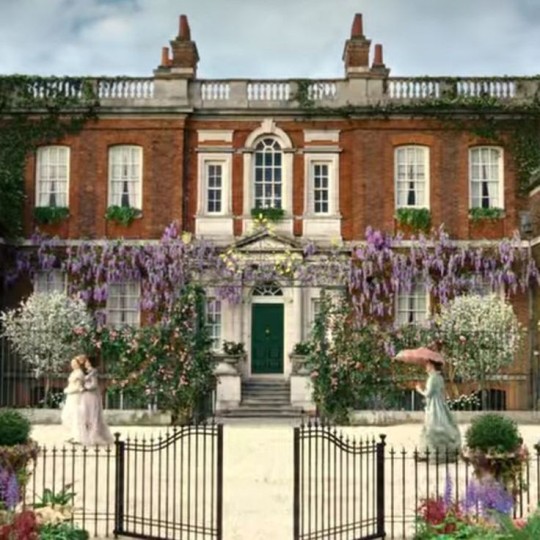
When we think of the Victorians, the grand old Gilded Age or the Edwardians, we all think of those big mansions and manors where some of our favourite stories take place. But what did a great house look like?
Layout

All great houses are different and some, being built in different eras, may adhere to different styles. But the layout of certain rooms usually stayed somewhat the same.
The highest floors including the attic were reserved the children's rooms/nursery and the servants quarters.
The next floor would be reserved for bedrooms. On the first/ground floor, there will be the dining room, drawing room, library etc.
The basement/cellar would be where the kitchens and other food related rooms would be. Servants halls and boot rooms may also be down here too along scullery, where sometimes a maid would clean.
Rooms used by Servants
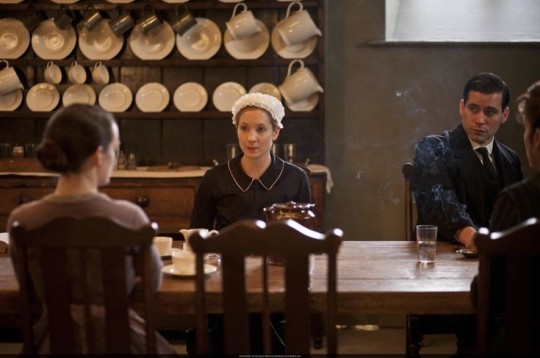
Boot Room: The Boot Room is where the valets, ladies maids, hallboys and sometimes footmen clean off shoes and certain items of clothing.
Kitchen: The Kitchen was usually either in the basement or the first floor of the house, connected to a garden where the house's vegetables were grown.
Butler's Pantry: A butler's pantry was where the serving items are stored. This is where the silver is cleaned, stored and counted. The butler would keep the wine log and other account books here. The butler and footmen would use this room.
Pantry: The Pantry would be connected to the kitchen. It is a room where the kitchens stock (food and beverages) would be kept.
Larder: The larder was cool area in the kitchen or a room connected to it where food is stored. Raw meat was often left here before cooking but pastry, milk, cooked meat, bread and butter can also be stored here.
Servants Hall: The Servant's Hall was where the staff ate their meals and spent their down time. They would write letters, take tea, sew and darn clothes. The servants Hall would usually have a fireplace, a large table for meals, be where the servant's cutlery and plates would be kept and where the bell board hung. (these bells were the way servants where summoned)
Wine Cellar: The wine cellar was where the wine was melt, usually in the basement. Only the butler would be permitted down there and everything would be catalogued by him too.
Butler's/Housekeeper's sitting rooms: In some houses, both the butler and the housekeeper had sitting rooms/offices downstairs. This was were they held meetings with staff, took their tea and dealt with accounts.
Scullery: The scullery was were the cleaning equipment was cleaned and stored. The scullery may even also double as a bedroom for the scullery maid.
Servery: The Servery connected to the dinning room. It was where the wine was left before the butler carried it out to be served. Some of the food would be delivered here to be carried out as well.
Servant's Sleeping Quarters: All servants excepting perhaps the kitchen maid and outside staff slept in the attics. Men and unmarried women would be kept at seperate sides of the house with the interconnecting doors locked and bolted every night by the butler and housekeeper. If the quarters were small, some servants may have to share rooms. Servants' bathrooms and washrooms would also be up there, supplied with hot water from the kitchens.
Rooms used by the Family

Dining room: The dining room was where the family ate their breakfast, lunch and dinner. It was also where the gentlemen took their after dinner drink before joking the ladies in the drawing room.
Drawing room: The Drawing Room was sort of a living/sitting room. It was mainly used in the evenings after dinner where the ladies would take their tea and coffee before being joined by the men. It could also be used for tea by the ladies during the day. The drawing room was seen as more of a women's room but any of the family could use it. The drawing room was a formal room but could also be used for more casual activities.
Library: The library is of course where the books are kept. The family would use this room for writing letters, reading, doing business with tenants and taking tea in the afternoons.
Bedrooms: The bedrooms would take up most of the upper floors. The unmarried women would sleep in one wing with bachelors at the furthest wing away. Married couples often had adjoining rooms with their own bedrooms in each and equipped with a boudoir or a sitting room.
Nursery: Was where the children slept, usually all together until old enough to move into bedrooms. They would be attended to be nannies and nursemaids round the clock.
Study: The study was a sort of home office where family could do paperwork, chill and write letters.
Dressing room: Dressing Rooms where usually attached to bedrooms where the family would be dressed and their clothes would be stored. The valets and ladies maids would have control of the room.
Hall: The hall was where large parties would gather for dancing or music or to be greeted before parties.
Furnishings and Decor

Most of these Great Houses were inherited which means, they came with a lot of other people's crap. Ornaments from anniversaries, paintings bought on holiday, furniture picked out by newly weds, all of it comes with the house. So most of the time everything seems rather cluttered.
As for Servant's Quarters, most of the furnishings may have been donated by the family as gifts. Most servants' halls would have a portrait of the sovereign or sometimes a religious figure to install a sense of morality into them.
#Fantasy Guide to A Great House#19th-20th Century#Anatomy of a great house#writeblr#writing reference#writing advice#writers on tumblr#writing advice writing reference#writing advice writing resources#writing resources writing advice#writing reference writing advice#Writing reference writing resources#Fantasy Guide#nobility#Servants#writing help
2K notes
·
View notes
Text
Fantasy Guide to A Great House (19th-20th Century)

(I know, I've been slacking but I'm still alive)
When we think of the Victorians, the grand old Gilded Age or the Edwardians, we all think of those big mansions and manors where some of our favourite stories take place. But what and who did it take to run a great house?
Meet the Staff

Large numbers of staff were always needed to run great houses. Every department had its own management and its own teams, all working together to ensure everything ran smooth. There was both an interior and exterior team.
Interior
You can split the interior of the household into three departments: Service, Upkeep and Food Preparation.
Service
Butler: The Butler was the Head of all the household staff. He acted essentially as the manager of a great house, directing the staff on a day to day basis or at events on the command of the lord/lady/employer. Make staff would report mostly yo him and he would be in charge of keeping an eye on them. The Butler had charge of the wine cellars, the dining room, sometimes the pantry as well. As the manager of the house, Butlers were afforded the title of Mr. X. Our favourite examples being of course Mr Carson and Mr Pennyworth.
Valet: The valet was the male servant who handled the dressing of the men of the family. He would be in charge of his master's clothes, ensuring he was always dressed in the right outfit for the right activity (there was a lot) and be in charge of helping him into the outfit in question. The valet would also be in charge of cleanliness, sometimes shaving his master or running his bath. Valets were referred to as Surname and ranked in how their employer's ranked, for example the Lord’s valet would outrank his son's.
Lady's Maid: The lady's maid was similar to the valet. She was in charge of keeping the ladies of the house looking their best and handling their needs. She would style hair, care for jewels, mend clothes, care for clothes and often act as a companion, accompanying her lady on visits or day's out. The lady's maid was referred to by their surname.
Footman: The footman was a male servant who served at table, fetched items, handled heavy lifting such as luggage, opened and closed doors. Most footmen were young men and en chosen for good looks. Footmen polished the silver services at great houses and when called upon would often take on the role of valet to guests without a servant to help. Footmen were referred to as their firstname. Footmen were denoted by rank, the highest being first footman who had charge over the others and would assist the butler in some tasks.
Upkeep
Housekeeper:The housekeeper was second in command but she ran her most of the interior staff, especially those who took care of the house itself. She supervised all female staff. She helped the lady of the house when it came to running events and caring for guests. The housekeeper is always Mrs. Surname even when she's unmarried.
Housemaid: Housemaids clean the house. They would dust, make and strip beds, straighten things up and keep the house looking it's best. The housemaid was a servant that was almost never seen, usually rising early, lighting the fires, cleaning the house as the family moves from room to room. She was called by her Firstname.
Scullery Maid: The scullery maid is the lower ranking maid. She would also have been younger and less experienced. She was in charge of the more unsightly work: laying the fires, scrubbing the floors, emptying chamberpots, cleaning servant's chambers. She may even do mending and washing for other servants. She was called by her first name.
Hall boy: The hall boy was also young and handled the worst jobs. He would polish boots belonging to the family and sometimes staff, cempty the servant's chamberpots and waited on on the higher ranking servants. He was called by his name.
Food Preparation
Cook: The cook or chef was the third highest ranking servant downstairs and they ran their own department. They were in charge of the kitchen staff. All cooks and chefs would meet almost daily with the lady of the house to discuss menus and ordering but would answer to both housekeeper and butler. As with the housekeeper, a female cook or chef is Mrs Surname despite martial status and make cooks/chef are Mr.
Kitchen maid: The kitchen maid helped the cook/chef in preparing the food. She would be one of the first servants up, in charge of lighting the ovens and starting the breakfast for the family and servants. She would clean the kitchen, boil water when needed and bring food up to the servery when needed. She would be called by her first name.
Exterior
The house would needed a team on the outside to handle the stables, the gardens and any outdoor activity.
Gardeners: They would be responsible for the upkeep of the grounds itself, caring for the gardens. There would be multiple at a great house led by a head gardener.
Stableboy/groom/kennelmaster: They would take care of the family's horses and dogs. They would take care of tack, help plan hunts and riding pursuits and handle carriages.
Chauffeur: As automobiles became popular in this period, a chauffeur was needed to drive the family and take car of their motor.
Lives of Servants

Servants were paid very little at this time, mainly because most staff got free room and board. Most of the interior staff would live in the house itself and be supplied meals. Chauffeurs, gardeners etc would live nearby on the estate either as locals or be supplied a house as a staff member. Staff uniforms were also supplied. Days off were rare but not withheld. Permission was needed to leave the house either to visit the shop or take a few days off.
Servants were expected to be obedient, modest and humble at all times. They were expected to stand in the presence of their master's, speak only when spoken to and never question an order. They had to be ready for anything at the drop of a hat. You've set for a dozen guests but now there's five more coming? Tough luck, change the table settings. You get seasick? Nevermind that, your gentleman is going across the sea and as his valet you're going with him, like it or not.
Servants from one house often travelled to with the family to their other residences: the butler, footmen, chef, kitchen maids, lady's maid, valet would all go with the family while everybody else would get left behind. Every house would have its own housekeeper if it could be afforded. Housemaids and other staff needed could be hired locally when needed.
The Daily Routine
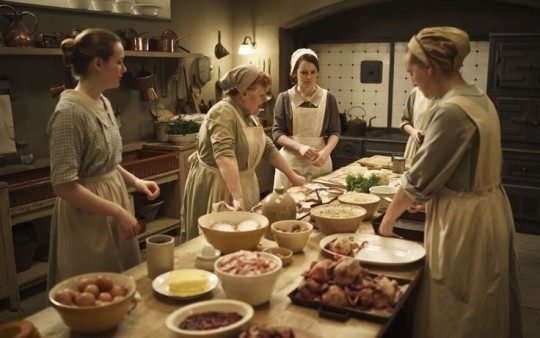
The working day of a servant in a grand house was a long arduous one.
Morning: At 6am, the servants rise. The scullery maid gets up and begins lighting the fires, starting with the kitchen. Then she cleans the kitchen top to bottom before the staff get in to cook. The kitchen maid would rise at the same time, helping with the cleaning. She would set for the servant's breakfast and start cooking it. The footmen open the shutters upstairs, cleans whatever tools they will need such as glasses and silverware, tend the lamps and sets for breakfast upstairs. The housemaids go about the house cleaning up after the night before, starting in the rooms that aren't being used (any room that's not the bedrooms). At around 8, the cook rises and starts the day. The kitchen maid serves breakfast to the other servants before returning to the kitchen to eat her own breakfast with the other kitchen staff. After breakfast, the housemaid will change her apron and deliver hot water to each of the bedrooms for the family. At 9, the family rise. Married women have breakfast in bed with all other family members and visitors eating in the dining room. Valets and lady's maids would have dressed them prior, gathering up any clothes to be mended or washed. The footmen and butlers will serve while the housemaids go into each empty room and begin their chores.
Midday: Just before midday, the chef would speak with the lady of the house to discuss menus. At around 11, the staff were permitted their first break, just enough time for a drink usually a cup of tea before they started again. The chef would start preparing for the main dinner of the evening with the lady's approval. Footmen would take their places at entrances or attend the family where he may be needed. At noon, the servants would have their dinner. At 1, the family would sit for their lunch. Once lunch is over, a footman might be permitted to attend personal business (with permission from the butler first) or be sent on errands out of the house such as delivering messages. While the family sit for breakfast, the maids tidy up any room they have been using since getting up.
Afternoon: The family take tea around 4. The footmen clear the tea before heading down to take their tea - a light meal- with the other servants around 5. Afterwards, the footmen will start to light the lamps, close the shutters and draw the curtains. The butler would oversee the laying of the table for dinner with the footmen. The first footman carries the silver, the second the china, while the butler sets the silver and glasses. If a guest is coming, a footman will remain on the door to see them in.
Evening: At 8, the footman or butler signals the start of supper. This is done by the rinibg of the gong or bell which gives the family and any staying guests, 15mins or more to get ready. Valets and lady's maids would already be upstairs at this point, helping their master/mistress. When the family head downstairs, they linger in the drawing room to chat while a footmen keeps an eye on them. Any guests visiting for dinner would be let in by a footman and announced upon entry. The butler announces dinner and escorts the family in. The footman serve the food while the butler pours the wine (chosen by the Lord with the butler's help). The footman stay in the dining room all throughout dinner, excepting when they go to the servery to collect the food from the kitchen maid. They serve and clear the plates for every course. When dinner is over, a footman will stay with the men while they drink their port while another serves the ladies their coffee in the drawing room. While dinner is on, the housemaid would tidy the empty rooms, check the fires and turn down the beds. At 9, the servants eat their supper while the family chill. When supper is over and the family is done for the night, the valets and lady's maids would ready their masters for bed. A footman would wait in the hall with candlesticks for the family and show any departing guest out. The kitchen staff would start to clean up while the butler starts locking up the house. The staff would get to bed about 11:30 - 12.
#Fantasy Guide to A Great House#Guide to A Great House part 1#Staff#Employment#Historical reference#Writing reference#writeblr#Writing help#Writers guide#Writing research#writers resources#writing resources writing advice#Writing advice#19th century#20th century#Edwardian#Gilded age#Victorian era
2K notes
·
View notes
Text
Etiquette of the Edwardian Era and La Belle Époque: How to Dress
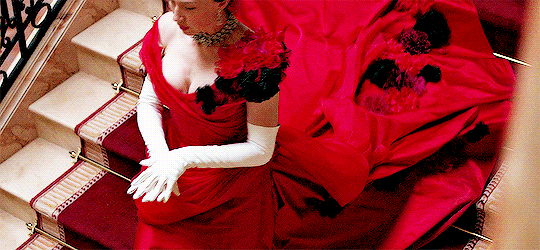
This is a new set of posts focusing on the period of time stretching from the late 19th century to the early 20th Century right up to the start of WWI.
I'll be going through different aspects of life. This series can be linked to my Great House series as well as my Season post and Debutant post.
Today will be focusing on the rules of clothes with this time period.
A Cut for Every Occasion
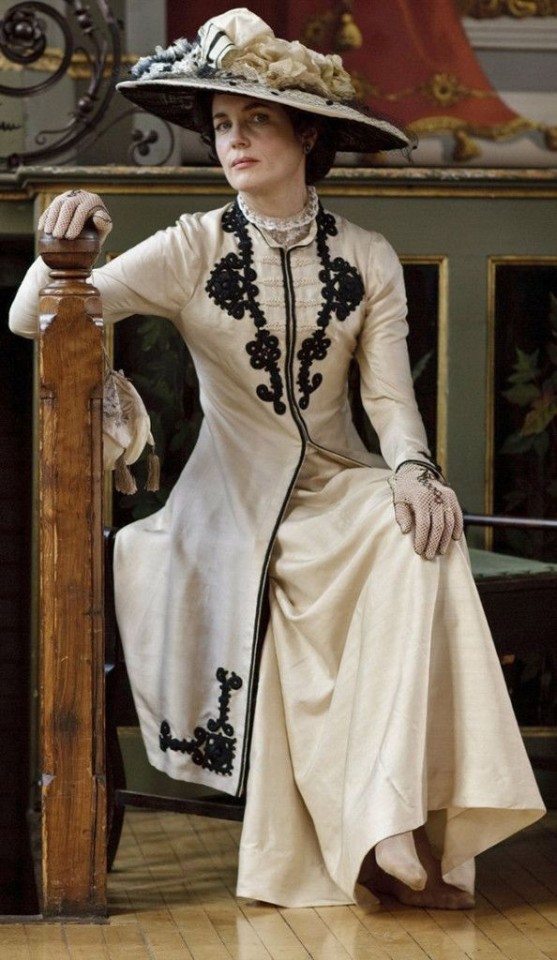
As you may know, the wealthy elite and their servants lived extremely regimented lives and every aspect was governed by careful rules. They would be expected to wear the right outfit at the right time, every minute of the day. Any misstep would be noticed at once and be subject to scruntiny.
In the circles of the elite, one would be expected to change for every occasion. One simply wouldn't wear the same outfit they've been lying around the house in to attend tea at somebody's house. Fashion in this era was dictated by the clock and by the event diary of the wearer.
Ladies

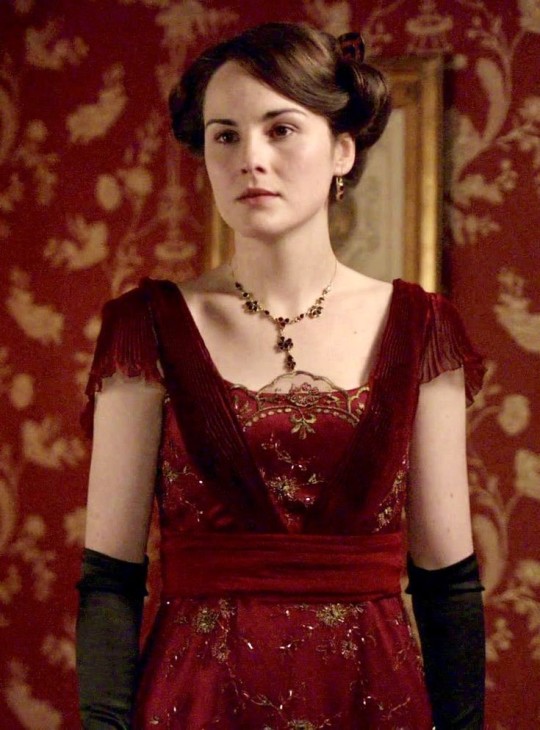
Women of the upperclass would be expected to change at least six times a day. When she would rise for a morning of repose around the house, she would simply wear a house gown or a simple blouse and skirt. If planning a morning stroll, she would change into a walking suit which is a combination of blouse, skirt and jacket along with her hat usually of tweed. If running errands or paying a visit to friends, she would wear another walking suit. If riding, she would wear a riding habit and a hat. If hosting tea or taking tea in her own home, she would change into a tea gown with is a lighter more airier gown more comfortable for chilling in. If attending a garden party, one wears a pastel or white formal day gown accompanied by a straw hat and gloves. For dinner, she would change into an evening gown which would be more elaborate and show off a little more skin than her day wear. After dinner and ready for bed, she would change into her nightgown.
Female servants had an easier time of it. A housekeeper and lady's maid would simply wear a solid black gown for the entire day. A cook and kitchen maids would wear a simple day dress for working with an apron. Housemaids would usually wear a print dress with an apron and cap, changing into the more formal black and white attire you would associate with a maid.
Gentlemen


The gentlemen had an easier time but they too were subject to changes throughout the day. Men were expected to wear a suit. The most popular day time suit was a sack suit. These were comprised of plain and loose fitting jackets, worn over a starched shirt with a high collar, waistcoat and straight trousers with ironed creases. These suits were exclusively wool with cheaper ones made of a wool and cotton blend. Grey, green, brown, navy were usual but sine younger men preferred louder colours such as purple which was a trend for a time in the 1910s. These suits were worn about the house or in the city accompanied by a coat. Men would change into tweed if shooting or walking. For garden parties, a gentleman would wear a light coloured suit, usually white and a straw hat. For dinner, a man had two choices: his tails or his dinner jacket. A dinner jacket was for less formal suppers say if dining at home. This was a collection of a jacket, trousers, waistcoat, a bow tie, a detachable wing-collar shirt and black shoes. Lapels of these jackets were edged with silk or satin. Tails were worn at a formal dinner party, at White Tie events. This was made up of a tailcoat, white piqué waistcoat, a starched dress shirt with a pique bib and standing wing collar with a white bow tie. Trousers were lined with trim to hide the seams.
Male servants were soared changing. Footmen would wear their livery around the clock which would resemble white tie to a certain extent or mimic court dress of palace servants. Butler's would wear a variation of a gentleman's evening suit throughout the day. When a male servant is dressed, he usually stays that way. However, a valet or a footman may be taken to pick up during shooting parties where they would wear tweed walking suits.
Jewellery
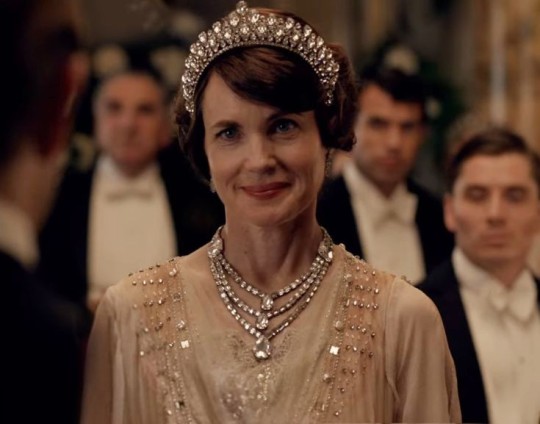
Jewellery was an important sign of status in society. Upperclass women of this time has access to untold caches of sparklers but there were rules concerning their use and meaning. Earrings were usually clip ons as women of high status would not pierce their ears. Simple, understated earrings were worn during the day with more ostentatious sets were worn in the evening time. Broaches were popular at this time, usually worn at the throat of a gown or blouse or walking suit or affixed on hats. Large stoned rings were worn over gloves while slender bands were worn under. Jewellery was intricate and understated amongst old money whole the nouveau riche went for chunkier stones and larger settings. Tiaras were only worn at White Tie events, held after six pm and almost never by unmarried girls. One would not wear a larger tiara than that most senior lady present. Men would wear tie pins, cufflinks and pocket watches to match any occasion be it for a jaunt on the town or at a formal evening party.
Hats
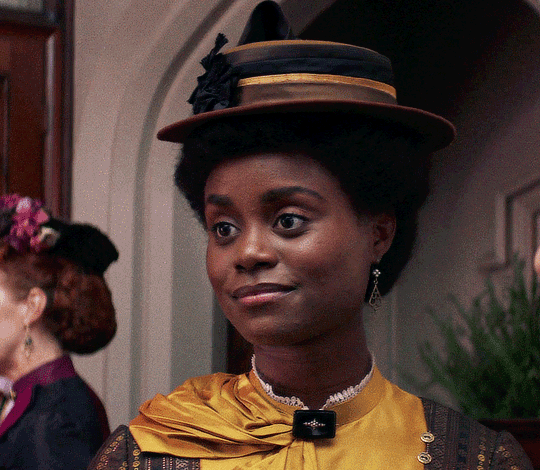
Hats were a staple in this period. Anybody respectable from any class wouldn't venture out of the door without a hat.
Men would wear hats when heading out but always remove them when entering a building, and never wear one without removing it for the presence of a lady. The bowler was seen as more a servant's headwear while a top hat was reserved for gentlemen. Flat caps would be only seen on gentlemen at shooting gatherings or in the country, they were popular among the common class for any informal occasion.
Women had more stricter rules concern hats. Hats for women were more a day accessory worn while out and about. A woman would not wear a hat in her own home even when entertaining and nor would any of the other female occupants if joining the gathering. A woman would not remove her hat when attending a luncheon or tea or any activity. Hats were held in place by a ribbon or sash tied under the chin or by a hat pin, which is essentially a large needle thrust through the hair. This was the period where women's hats became more ornate and rather large, leading to some critisism. Among servants, housekeepers and lady's maids would not wear a hat while indoors and working but a housemaid or cook or kitchen maid would cover their hair with a cap with housemaids changing into a more elaborate one come evening time. Male servants would not wear hats unless travelling or outdoors.
Gloves

Gloves are a staple in this period and worn only at the opportune time. Among servants, only footmen would wear gloves and usually only when serving. Butlers would never wear gloves. Female servants did not wear gloves.
Men did wear gloves, usually woollen or leather while outside or riding gloves when out on horseback.
Women wore gloves whenever outside. Day gloves were usually wrist length, with evening gloves stretching to the elbow. During dinner, evening gloves would be removed at the first course and laid across the lap, replaced at the last course when the ladies leave for tea and coffee after where the gloves are then removed again. Gloves are always worn when dancing and at the theatre or opera. If one is sitting in ones box and sampling some chocolate, one can remove their gloves for that.
Hair and Makeup
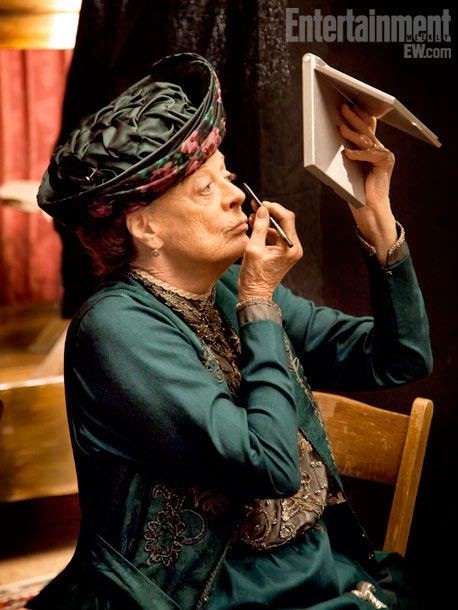
Make up was a no-no amongst the upper crust and for their servants in England and America, as it was seen as licentious but in France, the use of rouge was accepted. Perfume and cologne were acceptable but excessive use was frowned upon.
Hair was dressed by one's lady's maid. Bouffant updos were popular in this time period for married women. During the last years of this period, women began adopting the 'bob' but this was seen as radical and sometimes scandalous. Unmarried girls could wear their hair down, often with accessories like a bow to adorn their tresses. Servants would always tie up their hair and never be seen with it down or uncovered (though this depended on their job).
Men would comb their hair, slicking it back for dinner. Most men were clean shaven but if they wore beards, they were usually well groomed. Hair was kept short for grown men and teenagers but young boys may wear their hair longer whilst in the nursery.
#This bitch loooonnnnggg#Etiquette of the Edwardian Era and La Belle Époque series#Fantasy Guide#Early 20th Century#late 19th century#Great houses#writing#writeblr#writing resources#writing reference#writing advice#ask answered questions#writing advice writing resources#writers#Writing advice writing references#Writing references#Historical fiction#1900s#1890s#Fashion
576 notes
·
View notes
Note
Hi Duchess, I have a few questions I was hoping you would answer.
1. The princess in my story is around 18-20 and unmarried but she is the heir to an empire would she have ladies in waiting even though she’s still very young
2. Besides ladies in waiting what sort of attendants or staff would a princess of an empire have
3. I’m having her attended a school in a foreign country for diplomatic reasons, who would go with her?
4. What is security like for royal families? Do they have personal guards exclusively per person or just the royal guards and what extent does this go to how often are they accompanied and by how many guards? How does this change from when they are at the palace, roaming a city or in a foreign country?
Thank you so much! And I love your content it’s so cool how you know this much and help people out!
1. The princess would have a mixture of both maids (unmarried girls) and ladies (married) in waiting. As heir, she would have quite a few.
2. https://www.tumblr.com/inky-duchess/614295833994838016/fantasy-guide-to-employment-household-of-a-castle.
https://www.tumblr.com/inky-duchess/710727762409881601/fantasy-guide-to-a-great-house-19th-20th-century
3.
Https://www.tumblr.com/inky-duchess/738233106872598528/fantasy-guide-to-royal-guards
26 notes
·
View notes